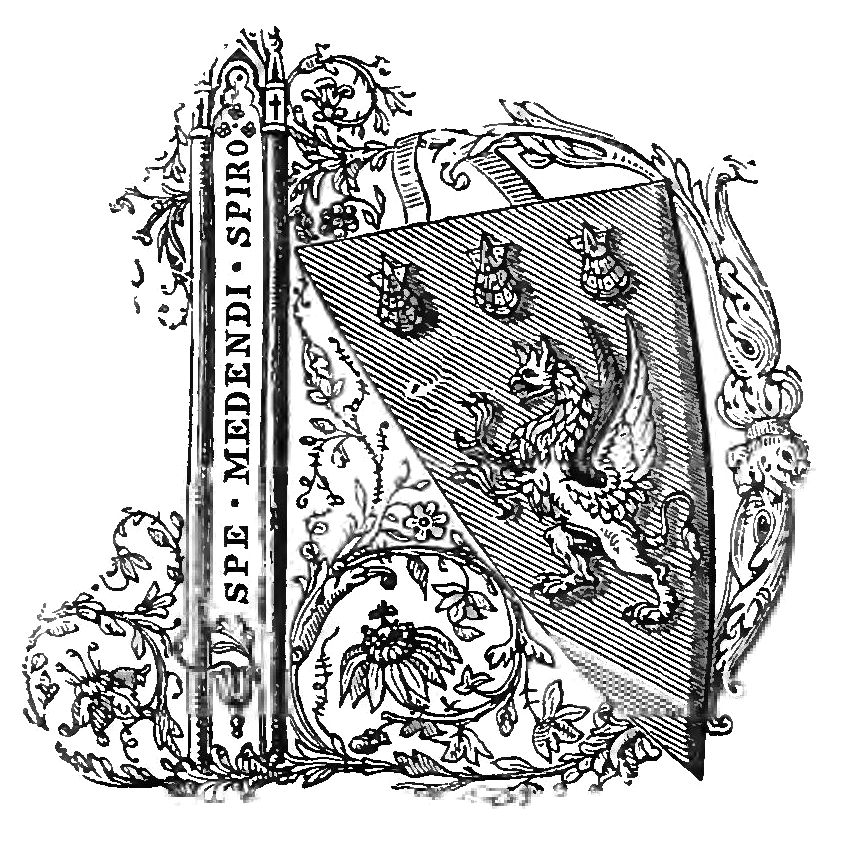* A Distributed Proofreaders Canada eBook *
This ebook is made available at no cost and with very few
restrictions. These restrictions apply only if (1) you make
a change in the ebook (other than alteration for different
display devices), or (2) you are making commercial use of
the ebook. If either of these conditions applies, please
contact a FP administrator before proceeding.
This work is in the Canadian public domain, but may be under
copyright in some countries. If you live outside Canada, check your
country's copyright laws. IF THE BOOK IS UNDER COPYRIGHT
IN YOUR COUNTRY, DO NOT DOWNLOAD OR REDISTRIBUTE THIS FILE.
Title: The Islets of the Channel
Date of first publication: 1858
Author: Walter Cooper Dendy (1794–1871)
Date first posted: Dec. 30, 2014
Date last updated: Dec. 30, 2014
Faded Page eBook #20141258
This ebook was produced by: Mardi Desjardins, Cindy Beyer
& the online Distributed Proofreaders Canada team at http://www.pgdpcanada.net
BY THE SAME AUTHOR.
THE PHILOSOPHY OF MYSTERY.
“We have the greatest pleasure in recommending the elegant and
laborious work of Mr. Dendy.”—Times.
“Drawn with fancy and elegance.”—Athenæum.
PSYCHE:
A Discourse on the Birth and Pilgrimage of Thought.
THE
BEAUTIFUL ISLETS OF BRITAINE.
Illustrated by 45 Woodcuts.
“We are delighted to join Mr. Dendy in his trip.”—Athenæum.
THE
ISLETS
OF
THE CHANNEL.
THE ISLETS
OF THE
CHANNEL.
By WALTER COOPER DENDY,
PAST PRESIDENT OF THE MEDICAL SOCIETY OF LONDON;
CONSULTING SURGEON TO THE ROYAL INFIRMARY FOR CHILDREN AND WOMEN,
AUTHOR OF “THE PHILOSOPHY OF MYSTERY,”
“THE BEAUTIFUL ISLETS OF BRITAINE,” “PSYCHE,” ETC.
“A thing of beauty is a joy for ever.”—Endymion.
Described and Illustrated from Sketches on the spot
by the Author.
LONDON:
LONGMAN, BROWN, GREEN, LONGMANS, AND ROBERTS.
1858.
LONDON:
SAVILL AND EDWARDS, PRINTERS,
CHANDOS STREET.
ISLETS OF THE CHANNEL.
From Southampton (Mail), Monday, Wednesday, and Friday,
11 p.m.
Fare from London, 1l. 11s. and 1l. 1s.
" " Southampton, 1l. 1s. and 14s.
From the Islets on same days, at 8 a.m.
Other Boats, Monday, Tuesday, Thursday, and Friday.
Return from the Islets, hour uncertain.
Fare from London, 1l. 5s. 6d., 17s., and 11s. 6d. Steward, 2s. and 1s.
" " Southampton, 16s. and 11s.
Half-fare for children from two to twelve.
Return tickets, 1 Month, 45s. and 35s.
From Weymouth, Monday, Wednesday, and Friday, at 8 a.m.
Return Tuesday, Thursday, Friday, and Saturday, at 7 a.m.
Other Boats, Tuesday, Thursday, Friday, and Saturday, at half-past
8 a.m.
Return Monday, Wednesday, Friday, and Saturday, at half-past
7 a.m.
Fare from London, 1l. 11s. and 1l. 1s.
Boat from Jersey to St. Malo’s, in 3 to 5 hours, Tuesday about
noon.
Boat to Granville on Saturday.
Excursions from Jersey to Sark and Alderney and round the Islet.
In Guernsey, chiefly French money: Jersey, chiefly British.
Chief circulation in Island one-pound notes. 12 British shillings
equal to 13 Jersey.
Hotels of all grades. Lodgings in town-houses and garden-villas.
Poultry and Fish cheap, especially in Guernsey. Tobacco and Tea
moderate. Milk plentiful, even in many cottages.
Wine, per doz.:—Port, 18s. to 40s. Sherry, 18s. to 36s. Madeira,
50s. Marsala, 15s. Claret, 16s. to 75s. Burgundy, 30s. to 55s.
Champagne, 30s. to 60s. Mountain, 20s. Hock and Moselle, 35s.
to 55s. Muscat, 25s. Chablis and Barsac, 20s. Sauterne, 12s. to 15s.
Grave, 18s. Champagne Brandy, 49s.
Horses, 6s. or 7s. a-day. One-horse carriage, 8s. Two-horse
carriage, 12s. to 15s.
ILLUSTRATIONS.
THE
ISLETS OF THE CHANNEL.
It was in the tenth century that the French King,
Charles IV., granted to Rollo the Pirate, who had
married his daughter, the Dukedom of Normandy,
together with the islets of “the wide bay of St. Michael’s;”
a guerdon for his conversion to Christianity. When
William, the descendant of Rollo, won the field of
Hastings, the islets became an appanage of Britain, by
the right of being conquered, and so they remain to this
day politically subject to Britain, although geographically
a parcel of France. The discovery of Roman, Celtic,
Runic, and Gallic relics and coins, and the ruins of
temple and fortress throughout the islets, reflect their
history on the olden time. Jersey, it seems, was the isolated
retreat of Ambiorix, a rebel to Julius Cæsar, if we rightly
interpret the sixth book of the “Commentaries.” These
Norman rocks, however, have not been held unchallenged.
The French descents date from Henry I., through the
reigns of John—who established the “Royal Courts,”
on a visit to the isles—of Edward I., Edward III., Henry
VII., Edward VI., George II., and George III., but they
were all failures, although Du Guesclin, who was commissioned
by Charles the Wise, seized and held Mount
Orgueil Castle. In the dilemma of “the Roses,” the
Norman Pierre de Breze assumed the title of “Lord of
the Isles” until the blending of these royal emblems.
The last attempt was on Jersey, in 1779-80, by the Duke
of Nassau, when Pierson fell in its successful defence.
During the joyous months of summer and autumn,
this fair group of islets will become more and more
attractive as the facility of communication increases,
especially as they possess the elements both of the salubrious
and the beautiful in a very high degree. Soft
and health-breathing gales are wafted along their very
lovely and bloom-spangled valleys; they are belted by
magnificent cliffs, indented by sheltered coves and deep
and darksome caverns, and by outlying rocks of the most
fantastic forms, and they are enriched, moreover, by quaint
and antique structures, emblazoned in remote history and
romantic legend.
There is a charm, also, in feeling that they are our own,
and that the genial atmosphere and the luscious fruits
and the light wines of France may be so perfectly enjoyed
without the inquisitorial annoyance of the system of
Passe-porte.
There are hotels and lodging-houses adapted to the
most economic purse, the direction to which may be
learned on board; and the markets will supply all the
delicacies an island appetite can desire. For the votaries
of health and joy the islets are thus exquisitely fashioned
by the bounty of the Creator, and the invalid and convalescent
may with confidence adopt them as a resort,
especially as the facility of sailing and boating on genial
waters offers delightful recreation without the exhaustion
of fatigue and the consequent evil of reaction.
The islets are fanned by southern breezes, yet the
tidal currents in their rock-bound channels, often running
seven knots in the hour, foam over the breakers in very
wild magnificence. The floods of the Race of Alderney,
Les Ras de Blansharde, between that islet and Cape
la Hogue, and even those of the Swinge between the islet
and the porphyritic rock of Berhou are proverbial, and
in very foul weather the boat may roll and ship heavy
seas in the passage of the Ortac within the crags of the
Caskets.
Through the Race run the boats from the Thames:
those from Southampton chiefly through the Swinge or
the Ortac: those from Weymouth direct in the open
channel to Porte St. Pierre in Guernsey, the most rapid
and pacific course for the languid and the delicate.
The geologic arrangement of the islets is in three
pairs. Jersey and Guernsey are inclined planes, shelving
from magnificent cliffs to a flat beach studded with rocklets;
Jersey trending southward, Guernsey northward;
the granite rocks of Jersey enclosing one-half, those of
Guernsey one-third.
Alderney and Serque are table-lands, raised on bases
of rock; Alderney irregularly belted—Serque completely
framed. Herm and Jedthou are mounds isolated by the
waves. Satellite blocks and ledges are lying in profusion
in the channels, some overwhelmed at high water. These
groups are exquisitely bold in outline and deep and rich
in colour, from the incessant play of wind and wave, the
pencils and the washes with which elemental art is still
heightening the wildness and the beauty of the creation.
The valleys and downs are prolific in bloom, and flowers
of the brightest and deepest colours adorn the more
cultivated parterres. In the deep, deep caverns, with
which the cliff and the bays are darkened, sport in their
almost sacred solitude the acephalæ and the actiniæ. In
the watery bosom of the cave, the male syngnathus may
nurse its infant brood in safety, and the delicate comatula
unfold its feathery tentaculæ. In the hollow cups scooped
in the granite and glittering with brine, the daisy actinia,
that Clytie of the rocks so loving of the light, may unfold
her enamoured florets to the sun. Then what
profusion and what variety in form and colour of deep
sea-weeds are thrown by the billows on the pebbles and
the sand; a spot richer both in these cast-away treasures
of the deep and in the living botany of the ocean, may
not be found than the caverned bays of eccentric Serque.
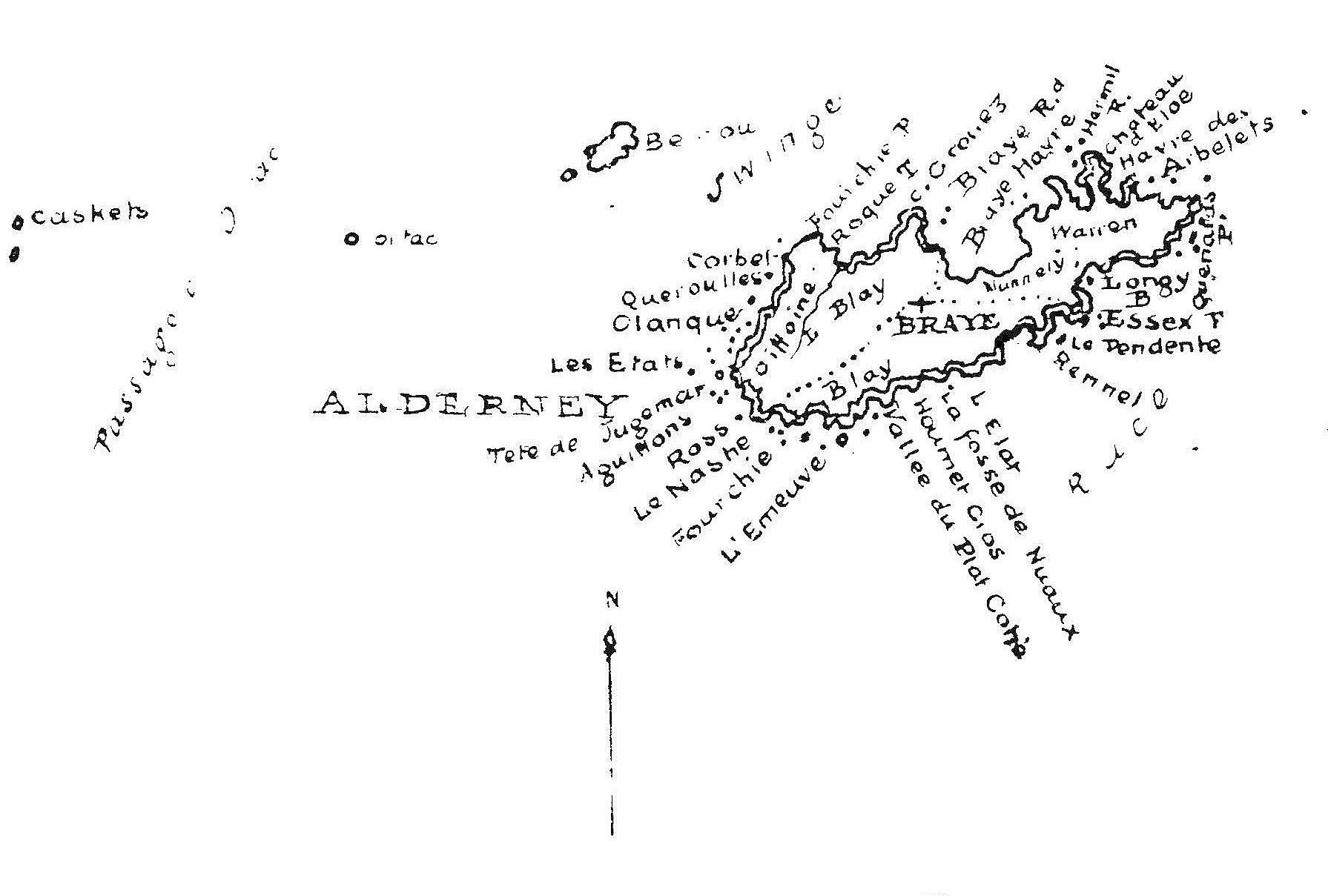
ALDERNEY
ALDERNEY:
AURENÊ—AURIGMA—AURIMA—ARENO—ABRENO—AURNE—ORIGNI—AURINÆ
INSULA—ISLE OF THE CAPE—ISLAND
OF ST. ANNE.
This lies nearest to the shore of Albion, within its
belt of shoals, and difficult of access in stormy weather,
even in its new haven of Braye la Ville, or Brayer. The
access was still more perilous in Crab Bay, or in the
more ancient port of Longy. We are landed. How
quiet the people, how social and primitive, how wedded
to old customs. It is probable, however, that in a few
years the harbour of Braye will display a busier scene,
much of the sterile land of the Giffoine be fertilized, the
petty farms multiplied, and the treasures of its fisheries
realized: but Alderney will never be admired, for dulness
reigns around, and the sea spray seems to excite
cutaneous maladies, and the salt and fish diet to induce
dyspepsia. There is, however, with its sterile aspect
and its dearth of foliage, a prominent and novel character
in Alderney. About its elevated centre is the quaint
old ville of St. Anne, possessing a new church (the
ancient fane being despoiled), a new court house, the
Government house, the gaol, the female school, and
chapels of dissent.
Of the ancient town on the south-eastern coast, of
which the oblong granite blocks of Les Rochers, near
the cemetery, are believed to be the debris, very solemn
legends are recorded. Its destruction is referred to the
judgment of the Deity on the crimes of a gang of
wreckers, who plundered and murdered the crew of a
Spanish vessel wrecked on the coast. This infliction,
according to the record, had its parallel in Jersey.
The Court consists of judge, jurats, attorney and
solicitor-general, greffier, sheriff, and his depute and
serjeant.
The ecclesiastical history is not without interest, and
there are seriously romantic legends of the mission
of Geunal, Vignalor, or St. Vignalis, the patron saint of
Aurigny. He was a scion of a noble family in Bretagne,
a proselyte of St. Magloire, and he resigned his abbacy
of Landenec, and became a missionary to Sark. From
thence he wended to Alderney, and converted the catchers
of fish and the tillers of ground, before this the most
desperate wreckers in the Channel.
From the outlying rocks on the eastern height stands
the ruined castle (La Chatte) of Essex, built, it is said,
by Robert Devereux, for the detention of his queen.
Below it, on the lower shore of Longis is a Roman cist,
noted by Holinshed; and Castrum Longini. Les murs
des bas, or the Nunnery, is a very antique square, with
corner towers, constructed with the Roman tiles of the
dilapidated ville. Here and also at Corbelets were discovered
antique vessels and coins and relics, and monumental
stones of porphyry and sienite.
On the coast heights there are batteries and watchtowers
and beacons, and a telegraph for Guernsey, all
dismantled in time of peace.
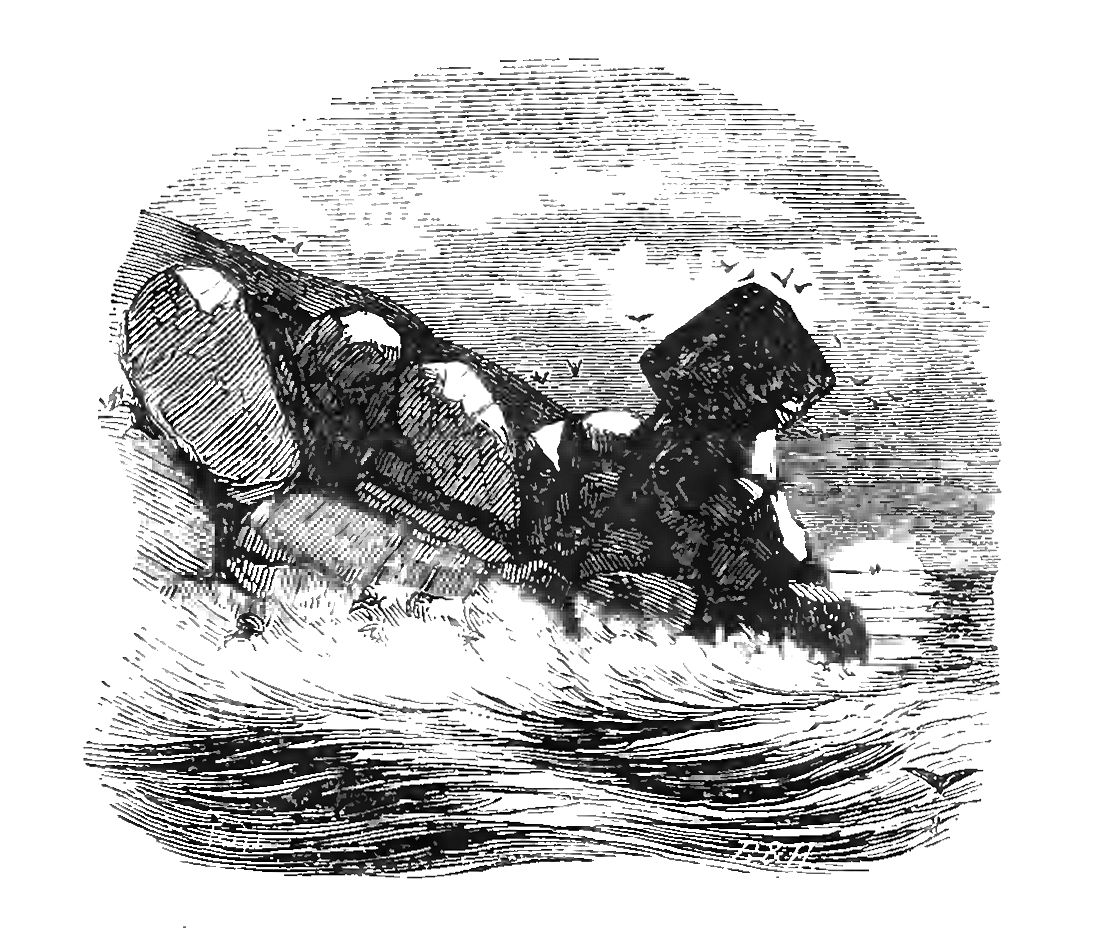
LA PENDENTE, ALDERNEY
The coast is one of the wildest belts of cliffs and rocklets;
those eastward of a line from Braye to L’Etat are
of ruddy grit, those westward of porphyry or hornstone.
The eastern group, more exposed to disintegrating forces,
assumes the columnar form, or that of hanging blocks,
as at Pendente; but the porphyry of the west is of the
wildest fashion. Between these strata is a narrow black
belt of hornblende and quartz, running north and south
across the islet. On the south-west point is La Nashe
Fourchie, the cones of Les Rochers des Sœurs, and the
secluded Chaise de l’Emauve, the Lovers Chair, a
record of the passion of Jacquine Le Mesurier for one
far lower than herself in rank. Of this romance the
story and catastrophe are just as interesting as the
common run of these love tales. Below the ridge of the
Giffoine there is the bold Tête de Jugemaine, and the
fine bays of La Platte Saline and La Clanque. On its
outlying rock is still celebrated on the first Sunday in
Lent, by youths and maidens, the ancient festa of Les
Brandons, the wild gambols being peculiar to the islet.
After dancing in the ring and kisses round, the corps de
ballet return to Braye in procession, waving aloft their
blazing firebrands, displaying all the wild gambols of
Comus. The islet is most exposed; it is therefore
bracing, yet the Cape Alctris and other exotics thrive in
the open air. About Longis and La Clanque a profusion
of fuci and algæ is thrown on the shore. The Haliotis
and Trochus shells lie on the beach, and myriads of the
strombiformis on the sterile ground.
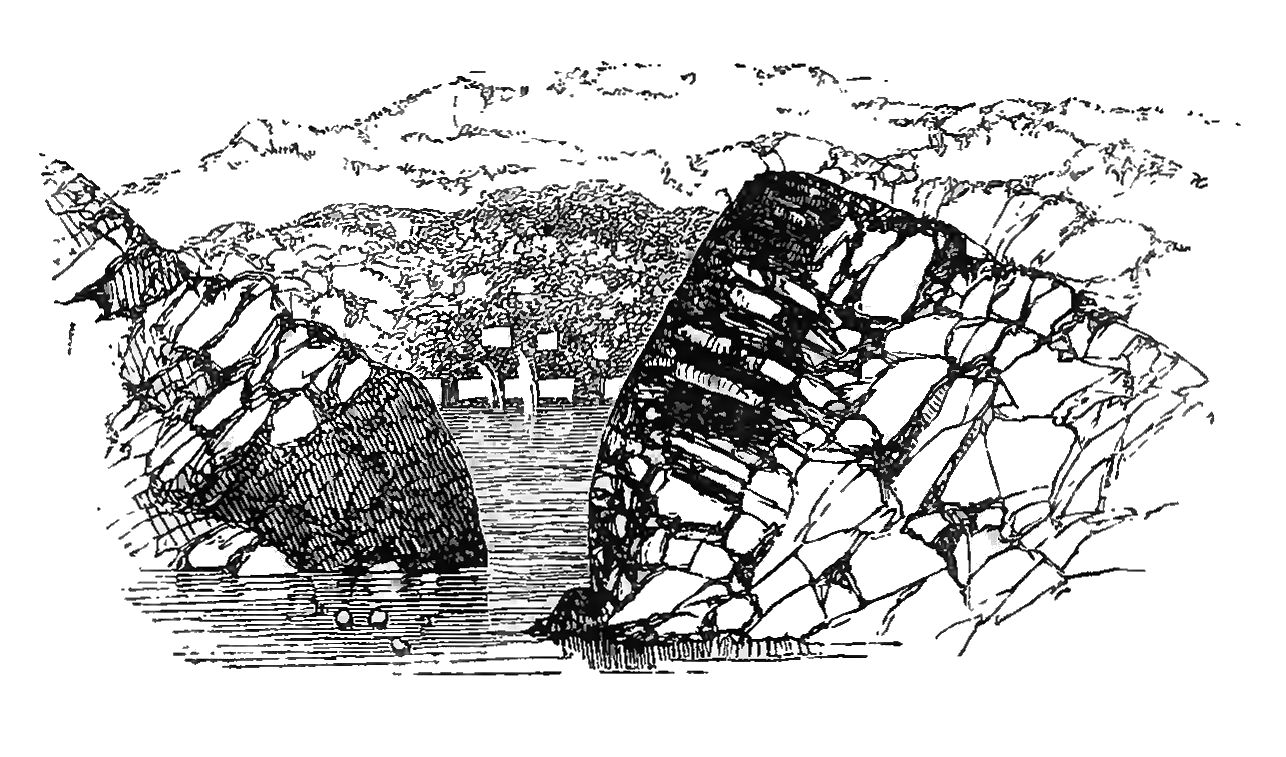
ALDERNEY, FROM BERHOU
In her course from England, whether in the open
channel or in the Ortac, the boat closes on the Caskets.
From the Weymouth course these lie off eastward. The
water is twenty and thirty fathoms deep around these
white sand rocks, which are about a mile in circuit, and
have two landing-places, with steps in the rock, accessible
in calm weather. The approach is perilous in a
storm; and it was off the Caskets that in 1120 Prince
William, the only son of Henry I., was drowned. The
platform is walled and surrounded by three light-towers
at triangular points. The sea block of Ortac and the
rocklet of Berhou lie between the Caskets and Alderney,
the latter rock being the resort of the Stormy Petrel,
the Barbalot, and the burrowing bee, one of the most
interesting little things in entomology. From this rock
the peep at Alderney is picturesque.
We are nearing the little Russell Channel, and surrounded
by blocklets: another of the sister islets is
looming in the distance.
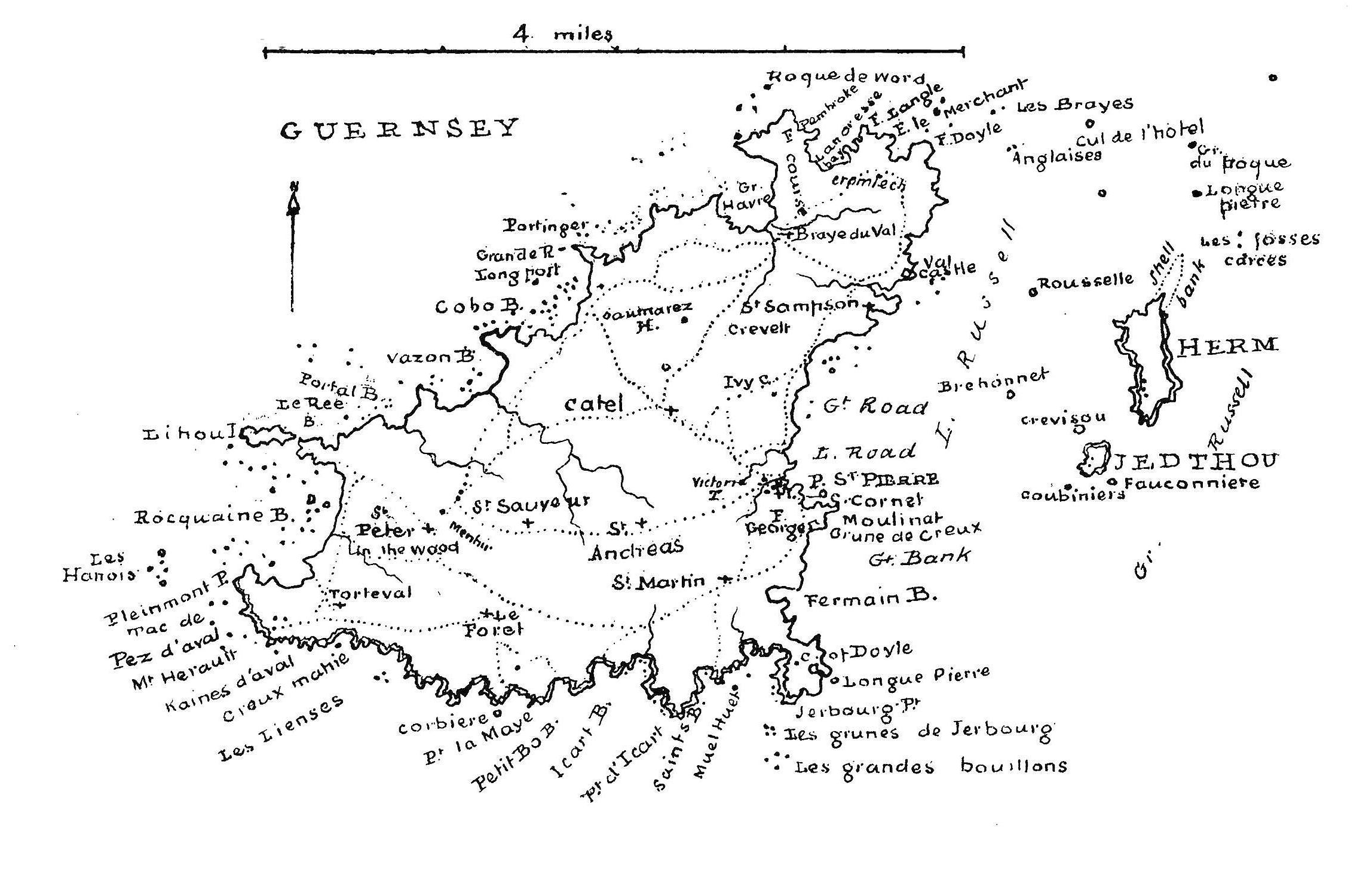
GUERNSEY
GUERNSEY:
CÆSAREA—SARNIA.
Passing between the point of Vale and Herm, we are
directly off the harbour of St. Peters Port, its fort of
Castle Cornet crowning an isolated granite rock, southward
of the pier, which now connects it with the shore,
and forms the harbour of refuge. The coup d’œil
assumes a perfect Norman aspect, and the costume,
dialect, and manners are in just harmony with the
scene. The marine quarter of the “town,” as it is par
excellence termed (and indeed there is no other in Guernsey),
especially the old church, the hotels, and wineshops,
of dark grey stone, with which the quay is lined,
is perfectly continental. The shops and offices, of
more modern aspect, compose the streets; the dwellings
of the opulent, among which Castle Carey is conspicuous,
are chiefly on terraces along the abrupt
escarpment; Elizabeth College, the modern church, and
the Victoria Tower, by the cemetery, on the new ground,
being the most prominent public objects. The old
church on the quay, dating about 1120, is crucial, the
interior being darkened by its massive columns and
heavy galleries.
The marble slabs of the fish-market are profusely
supplied with choice fish—turbot, dorey, and very fine
crustacea; and the stalls teem in the season with the
treasures of Pomona.
The education at the College is economical, about £12
per annum; the cost for living with the Principal not
exceeding £60.
The influence of this facility of learning will enlighten
the minds even of the unlettered islanders, among whom
there is a prevalent superstition. The belief in witchcraft
may still be discerned, although it is now two
centuries since women were tortured, hung, and burned
under this demoniac creed.
The scenic quality both of the interior and of the
eastern and northern coasts of Guernsey is mere prettiness.
On the south, however, from Fermains Bay to
Rocquaine it is buttressed by some of the most magnificent
rocks in the Channel, the land gradually descending
from them northward. The coast rocks on the east,
south-east, south, and south-west, from Saline to
Rocquaine, are of gneiss, those of Rocquaine are of
schist, and thence they are granitic.
A line from Vagon Bay on the west through Catel to
Amherst cuts the islet into two unequal parts, differing
in geological character. Much of the bed of the northern
portion is alluvial; some, indeed, embanked from the
sea by General Doyle. The southern is a more elevated
platform, and consists of a series of undulating hills, and
sloping bosky lanes, and little glens with rippling runnels,
until the highest downs dip at once into the waves
their magnificent gneiss cliffs, rounding into beautiful
bays, embossed with outlying rocks, and worn into clefts
and fissures, or running up into exquisite little dingles.
This magnificence is confined to the south; the sea and
coast views, however, to the east, are finely backed by
the islets of Herm and Jedthou, and the more distant
ridge of Serque.
Guernsey is an easy study; it may be coasted and
threaded, and its objects of natural and archæological
interest analysed, in four or five days. In calm weather,
however, the cliff beauty of the islet may be contemplated
more perfectly from a boat, surveyed from Fermains
Bay to Les Hanois.
The coast from Port St. Pierre to St. Sampson is flat,
and studded with rocklets, on which loads of vraich and
laminaria and asperococcus are profusely strewn. These
algæ are gathered and dried for fuel, at the legal harvest
time, in March and July, the harvest home being profusely
supplied with vraich cakes and bread. The
digging and blasting of the quarries of black stone, and
the tiny windmills that drain these excavations, give life
to the scene as we approach St. Sampson’s.
Martello towers crown several of the brows, and there
is within very old walls to the left a little remnant now
styled Ivy Castle. It is not worth the visit, although it
is a bit of a castle, built by Robert of Normandy, contemporary
with that of Jerbourg.
We are close to the archæological gems of the islet,—the
churches of St. Sampson and Braye la Ville, or du Val,
within a mile of each other, at each end of a flat alluvial
isthmus. The first is dated 1111, its name being derived
from Sampson, Bishop of St. David’s, consecrated
Bishop of Dol under the Duke of Brittany, and endowed
with these islets by Childebert of France. He came to
Guernsey, and built a chapel here. There are three
aisles, with massive pillars and Norman arches; the old
gallery-loft and the tower are in exquisite antique. It is
profusely covered by most luxuriant ivy with enormous
stems.
The steeple of Braye du Val, dated 1117, is very
eccentric, immense granitic blocks lying before the
belfry-door.
At low water we cross the harbour of St. Sampson’s,
Vale, or Du Val, on stepping-stones. The Castle on the
mound was erected as a defence against the incursion of
the Danes, and then called St. Michael’s, or the Castle
of the Archangel. There is a legend imputing its erection
chiefly to a band of military monks, who, in a sort
of holy pilgrimage, made a descent on the islet.
A Druidical carn lies on the hill, half a mile northward
on the left of the road. There are twelve upright
and three immense horizontal stones. The largest of
these, fifteen feet long and a yard thick, rests on four
uprights, the second only on two, the third on the
second and the edge of the pit, so that six uprights are
unoccupied. From this brow there is a perspective view
of the chief objects in the islet, Alderney lying on the
horizon to the north-east.
Forts Doyle and Pembroke are on the northern point
on either side of Lancresse Bay, the bay of “Anchorage,”
in which the Duke of Normandy landed in a storm, as he
was sailing over to England to Edward the Confessor.
The shores and bays are here flat and dull; as we
leave the Race Course and pass Portinger and Long Port,
the upheaved blocks of gneiss increase in number and
proportion. In Cobo Bay stands Le Grande Roche; its
veins of rose-coloured feldspar are unique. Here and
there we have picturesque glimpses—one of the flat islet
of Lihou, once hallowed by a priory built in the reign
of Henry I., the grouping of cots and walls still in bold
relief. The outlying rocklets are profuse between Le
Grand Havre on the north and the bold blocks of Les
Hanois or Hanoreaux off Pleinmont Point, the west
corner of the islet; they completely stud the bays of
Port du Fer, Saline, Long Point, Great Cobo, Vazon,
Perelle, Le Rie, Rocquaine, the widest bay in Guernsey.
It was in Vazon Bay that the Spaniard Yvon de Galles
descended and fought the battle in which the islander
Jean de Lesoc performed feats of great valour. The site
of this conflict is still named La Bataille.
In contrast to this record of history is a fairy legend.
In this bay of Vazon was “Les Creux des Fées,” a
cavern haunted by the little people. Why and when and
how we know not, but they conquered Guernsey!
A sterile sameness reigns around Pleinmont Point and
Mount Herault and Creux Marie, a cavern 200 feet
deep, and Le Corbière, until we reach Point la Maye.
In the vicinity are the old village churches of St. Peter
in the Wood, of the æra of Henry II., 1167, and Torteval,
still more ancient, of the æra of Henry I., 1130, which was
erected by Philip de Carteret and dedicated to his Saint,
Philip, after a vow during a storm in Rocquaine Bay.
There is the menhir stone in a meadow by one of the
lanes.
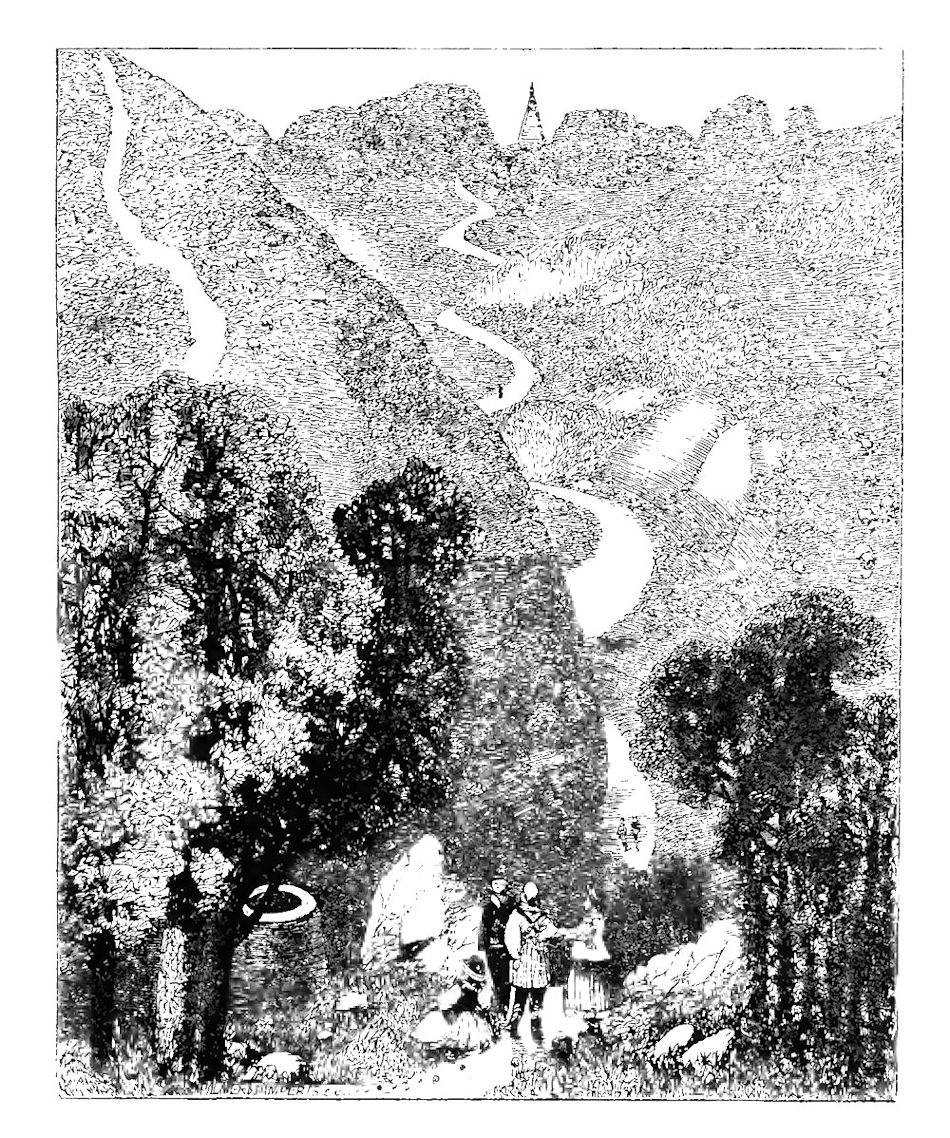
LE FORÊT, GUERNSEY
The highest peak of the islet is the perpendicular
cliff eastward of Maye Point, rising to 300 feet—with
offset rocklets and caverns or slits in perfection. After
the steep descent to the north-east into the little cove of
Petit-bôt, we mount abruptly to a very fine brow, Mount
Hubert, the name associated with the chase, and as we
are now in the district of Le Forêt, we may believe that
we are on the site of sylvan sport in the olden time.
The dingle over which we look to the elevated church
of Le Forêt, on the opposite brow, reminds us of the
ravines of Devon or Man, the road winding in zigzag
down a very deep valley with a rippling streamlet at its
side. We are now on the brow over Icart Bay, the wildness
and breadth of its waters spread out far below us.
The sienite rocks are finely chaotic, exactly grouped for
the pencil, and among the best studies in the islets; and
around us we may discover very luxuriant patches of
lichen—among them the Roccella Tinctoria, or Orchel,
to which we owe many a bright olive dye and the litmus
paper so essential as a test. Another descent to eastward
brings us to the most exquisite little cove, Saint’s
Bay; the huts and nets and grouping of fishermen are
on a ledge of the rock, adding life to the otherwise
solitary scene. The martello tower that was to guard
the descent of the gorge, like a Border peel in Scotland,
is properly perched to carry off the cliffs. Crossing Bon
Point, the most fantastic outlying rocks of Muel Huet
at once arrest the eye; disintegration has left them at
present almost as caricatures. Leaving St. Martin’s on our
left, the high brow of Jerbourg rises eastward, on which
there is a lofty column to the memory of General Doyle.
It is the finest point for a panorama of the isles; Herm
and Jedthou beneath us, Serque and Jersey extending
their long grey ridges in the distance. The lines at
Fort George commanding the road and the port are
dismantled; from the eastern bastion we gain a very fine
bold view of the harbour and Castle Cornet, with the
eastern coast to the Castle of du Val, Alderney, lying on
the horizon. And so we accomplish the coast route of
Guernsey.
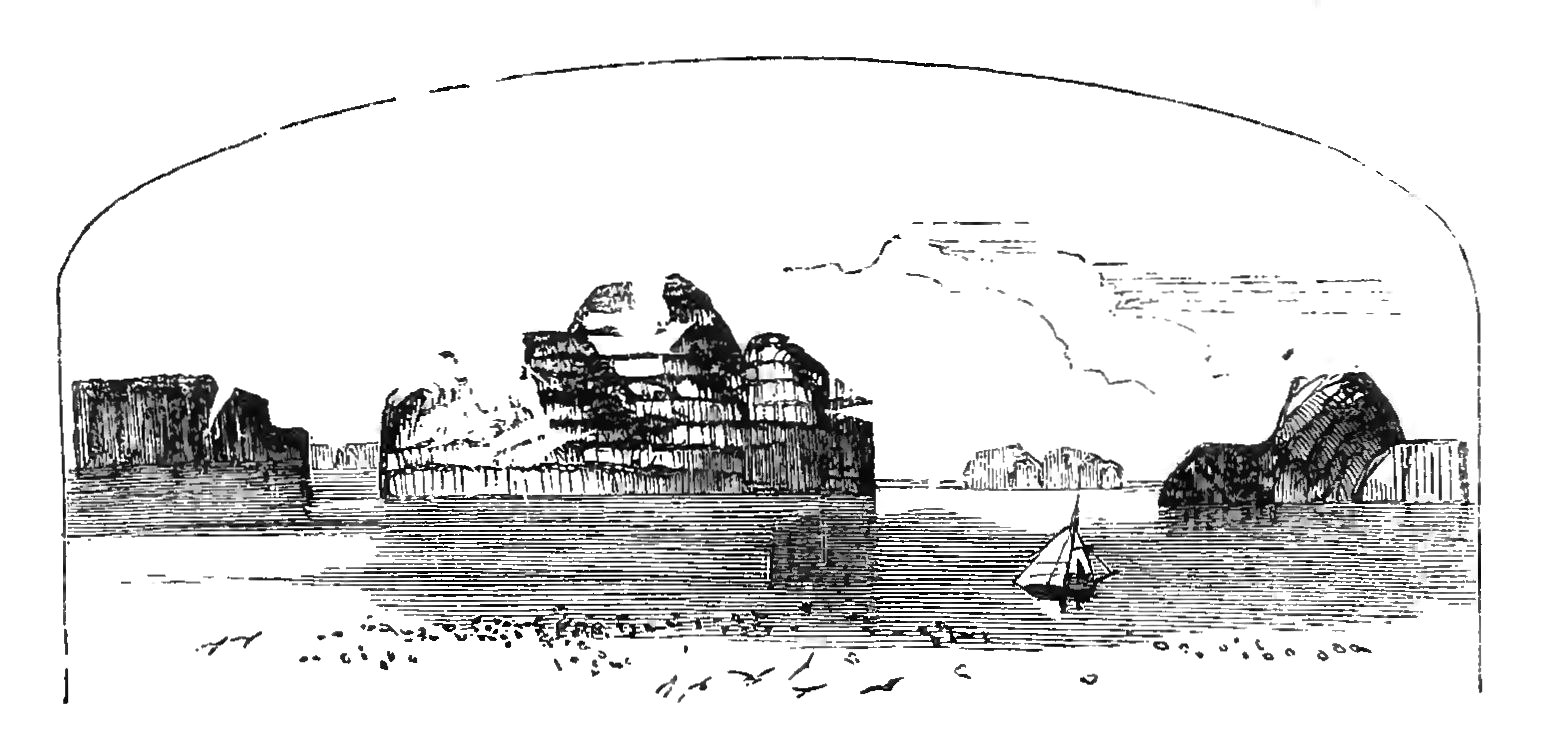
MUEL HUET
It is early evening in summer: wandering in the
interior of this floral islet, we are directly surrounded by
pretty quiet hamlets and homesteads: the abrupt lanes
are lined and feathered by underwood of very luxuriant
yet dwarfish growth. The little gardens are glowing
with flowers, and they, as if to shame the forest by a
contrast, attain a gigantic height, their colours being
exquisitely deepened into perfect beauty. The tree verbena
rises twenty feet; camellia, oleander, myrtle, aloe,
cystus, blue hydrangea, fuchsia, geranium, magnolia,
all blooming profusely in the open air; amaryllis, the
Guernsey lily, being here unparalleled. The heliotrope
overruns its bed in the wildest luxuriance—a carpet of
the richest dyes more beautiful by far than the cloth of
gold of Hindustan, and on which Flora might well hold
her Court of Blossoms—and the canna indica is now a
denizen in the islet. And here on the brow is the village
of Catel, looking down and across the flats to
Braye. The antique church of the twelfth century,
frowning in dark stone, adds subject of high interest to
the bright landscape around us. And look at that
eccentric daub within it—three knights on horseback
with falcons, and three skeletons lying on the ground.
It is somewhat tempting to hatch a legend, but we refrain
in pity, especially as the ovum is addle. There
are, however, real records of the ceremonial magnificence
with which these islet churches were consecrated, that are
truly entitled to a remembrance. Bishops and abbots
and feudal lords, with their trains of vassals and servitors,
were wont in days of old to take, we hope, a holy
pride in assembling to grace the consecration with their
state. Still more fanciful is the romance of the Well of
St. George, near Catel, which is fraught with a very
potent charm. St. George beats St. Valentine hollow;
for a maiden has merely to make a votive offering to this
Saint at his well nine days in succession, and lo! if she
looks then into the well, she not only sees her lover, but
may claim him as her right. So he becomes a Benedict
will he nill he.
From the slopes as we walk are the home peeps down
the lanes and across the dingles, with the church of du
Val, and a windmill, and an arch, and the martello of
Crevelt, composing pictures of quiet beauty; and amid
such fair scenes we wander along to St. Peter in the
Wood, and St. Sauveurs (near which is the Beacon Hill,
La Hogue foque,) and St. Andrew, all consecrated by
ancient fanes that claim the era of Henry II.
And there in the hall of an old manor house—for we
are bold in our peregrination, and assume all the invasive
liberty, the freemasonry of curiosity—there, in the hall,
we look on a large couch covered with dry grass, fern,
and heather; and what doth it import? It is the Lit de
Veille. On this bed, during the dreary evenings of
winter, assemble the maidens and youths of the isles,
and there they sit and huddle or recline often beneath
festoons of autumnal or dried flowers, and beguile the
hours with song and chat, and thrifty needle too, forming
a group worthy of the pen of Boccaccio or the pencil of
Watteau.
HERM AND JEDTHOU
Are lying along in a lake of molten gold, for so smiles
the Channel in a calm evening of July. We are rowed
across with sketch-book and wallet and hammer.
Jedthou—Grande Hogue—as it was a famous beacon-hill
or watch-tower, is not more than a mile long, offering
fair rock subjects for the pencil, with its satellite blocks,
Fauconnière, Goubinier, and Crevisou, for every block has
a name.
Herm is two miles in length, and is deeply quarried.
Rabbits are burrowing among its rocks, and very small
crustacea lie profusely around its shore. But there to
the north is spread its carpet of sand and its shell beach,
on which we may chance to gather very choice specimens:
for instance, chiton, lepas, pholas, solen, tellen, chama,
cypræa, voluta, haliotis, murex, and sponge and coral. It
is a treasury of wrecked shells; probably among the
granite there is a lack of lime for the construction of
shell, so as to yield a profusion of living shell-fish.
On such a night, and the currents calm, we may row
across the Channel by moonlight to Port St. Pierre, as
safely as we may float in a gondola across a lagune in
Venice. The moon has lighted on our slumber, and at
the earliest sunbeam we start from our couch, and we are
looking on a long amethystine ridge just coming out of
the morning haze, and thither are we bound.
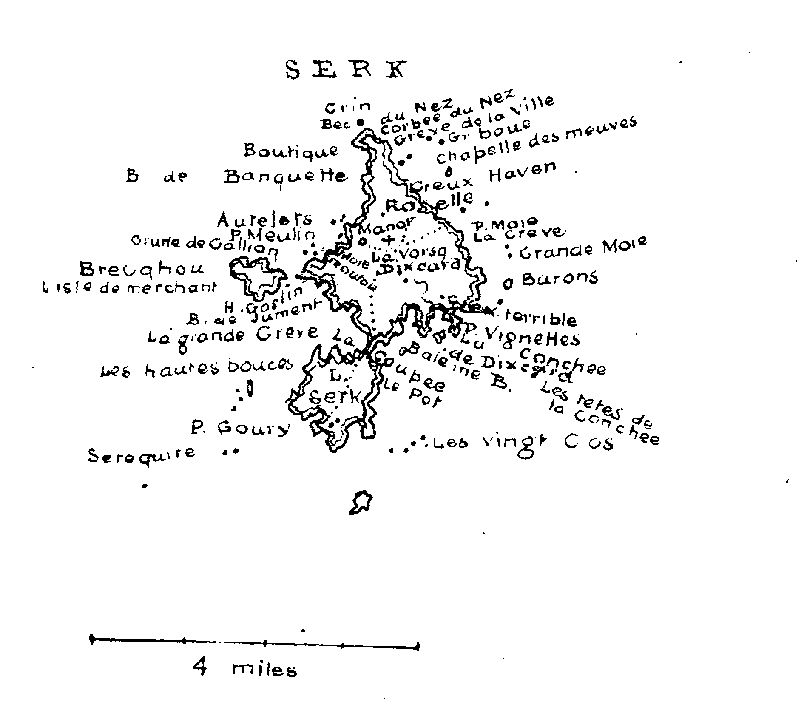
SERK
SARK:
SERK—SERQUE—GERS—L’ISLE DU CERS—SARNICA.
This exquisite little islet is lying before us, eight miles
off; yet we may often gaze on it with longing eyes, even
from the pier in Guernsey, with boats of all kinds, even
the Lady (cutter) of Sark floating around us, without a
hope of landing on its guarded rock.
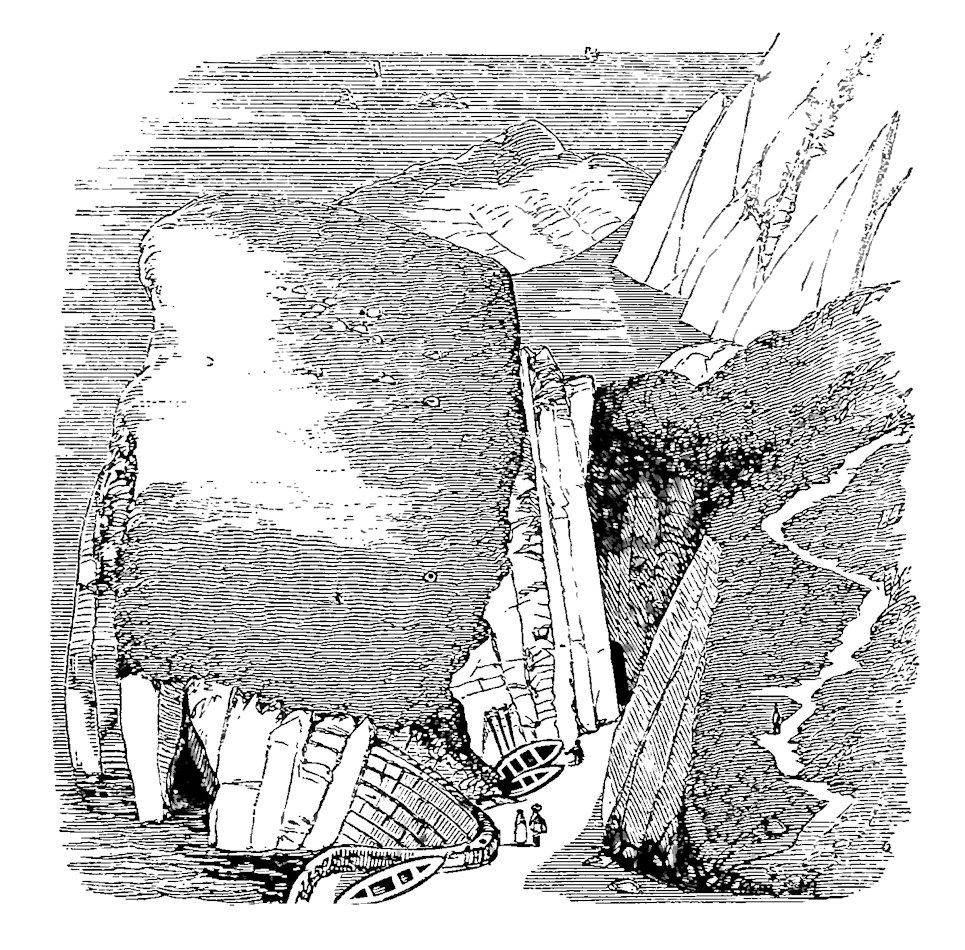
LE CREUX HAVEN, SERK
Now this little Serque was the cell of St. Magloire, an
Armorican or Brittany bishop, and here he prayed and
fasted himself into fitness for the conversion of the
Channel islets. This cell, in the reign of Edward III.,
was still a ruined relic, and the islet was then a nest of
corsairs: it still assumes a sort of wild or neutral aspect.
In the reign of Edward VI. or that of Mary, the
Flemings took it by stratagem, but in 1565 it was
securely colonized by Hilary or Helier de Carteret, Lord
of St. Ouen’s, under a grant from Mary and from Elizabeth
of fief en Hubert, a guerdon for knight’s service.
There are monumental stones indicating its association
with the Britons, and the Romans we believe were not
ignorant of Serque. The plan of this little gem is
highly eccentric: a table-land, four miles long, two
miles its greatest breadth, and five feet! at the narrowest,
spread on a majestic pile of rocks deeply indented with
bays and coves and clefts, and fringed by groups of
rocklets and ledges, in all the fantastic fashioning of the
elements. These outposts, by increasing the difficulty
of access, impart a deeper interest to the islet, scarcely
alloyed by the slight sense of peril, for we are confident
of being safely wafted, D. V., by the superior skill of the
Serque boatmen, even among breakers and conflicting
currents, into the tiny cove of Le Creux. So our Lady
of Sark is safe at her moorings, and we are rowed into
this puddle of a harbour, completely overhung by perpendicular
cliffs, 200 feet high, and richly clothed with
velvet mosses and lichens, a complete study for Salvator
or our own Pyne. This is the only point for landing in
certain states of current or surf, although in very calm
weather there is an available cove to eastward, and the
daring may be run ashore in the bays. But even from
this beach we have no natural mode of escape. A tunnel
in the cliff opens by an arch, over which is the date
1688, the year of its construction by the Carterets; and
so we walk out and up between green hills chequered
with heath and rock, with triumphant pride at thus carrying
the mighty earthworks which the Gnome and the
Triton have raised around their granite home. And so
we seek our hostelry, and find it in a capital farm-house,
and we are soon engaged with Madame Vaudin in a cosy
chat, in which come out, so unexpectedly, records of our
lamented friend, Sir John Franklin, who years ago
sojourned in our very chamber, and slumbered within
those green curtains; and all this while the fish and the
ducks and the puddings, bathed in exquisite cream, are
being prepared for our luxurious and most economic
feasting. And then, in the kitchen, we discuss the
statistics, the poetry, and the government of the islet
with this ancient, clever dame. Of this it is enough to
record, that there are about forty yeomen, tillers of the
land, in Serque, the magistracy of the isle, quite a
Venetian Senate; one of whom, we believe, may try a
cause, subject, however, to an appeal to the forty, and to
the Seigneur or Lord of Serque, who is of course their
president. They are their own law-makers, not subject
to the enactments of our legislature, exchequer, or customs;
the only duty paid to England being a sort of
quit-rent of £2 per annum.
Our hostelry is in the pretty village of Dixcard, a
few scattered houses forming the ville of Le Vorsque,
the chief rendezvous of the Serque islet, nearly in its
centre. The dingle runs nearly across the islet, winding
for about a mile between lofty brows down to its bay,
and may form a line for our promenading—the northern
and the southern walk. The beauties of the coast of
Serque, however, should be revelled in; they are worth
more than a glance and away, and after a rapid survey of
two days, we may wander away in any direction from our
central roost, and be sure of descending in a score of
minutes to some beauty of the rocks, some cove or block
or boutique, the names of which, though sadly mutilated
by the islanders, we will essay to record.
Our first walk is by the church and the scattered ville
of Roselle and the Seigneury to the northern cape.
This house of the lord is in the Tudor style, and boasts
a lake, a boat, a bowling-green, a flagstaff, and a belvidere,
and parterres and greenhouses of choice and beautiful
flowers; and it is near the head of a ravine leading
down to the most exquisite cave of the islet.
And here we are on the promontory of Point le Nez,
the first cape on our scud from Guernsey. The terminal
rocks are insular at high water, but Le Bec du
Nez may be reached on a ledge at ebb of tide. On the
brow the schist blocks, traversed by porphyry, are
upheaved in the wildest confusion, and assume an endless
variety of form, more so than the shore blocks,
which are washed and rolled and rounded by the
waves. It is a fine wild range to begin with. The turf
down invites us even to an Olympic race, for the pure
air elevates both the will and the power of our frame.
We feel our muscular energy almost grow upon us, and
when we have revelled on the turf, then down among the
white, smooth rocks that lie scattered around in chaotic
rudeness, like the thrones of Titanic nobles. But prolific
nature has gemmed these blocks for a more charming
study than mythological fancies; there is a garden of
lichens strewn for our special admiration on their surface;
there are the golden studs of squammaria, and the
grey and purple bosses of parmelia; and if we peep
between these stone giants, we shall light on many a
lovely flower and rich green plant, blooming and luxuriating
within little nooks, and nursed by their genial
shelter. The scolopendrium and hart’s tongue are long
and broad in leaf, and the grammitis expands its fronds in
profusion; and here we breasted one of the most violent
gales of the Channel, not without some peril, for it was
often difficult to hang on; but the wind blew into us
such a joyous and refreshing energy and power that this
clinging to the rocks was no labour. Our sketch-book
was not so fortunate, it was whirled from our grasp in a
moment, and dashed against a towering block. We
rushed wildly to save our treasure, but four or five of our
favourite sketches were wafted in a few seconds high up
among the clouds, imparting a deeper value to the
salvage.
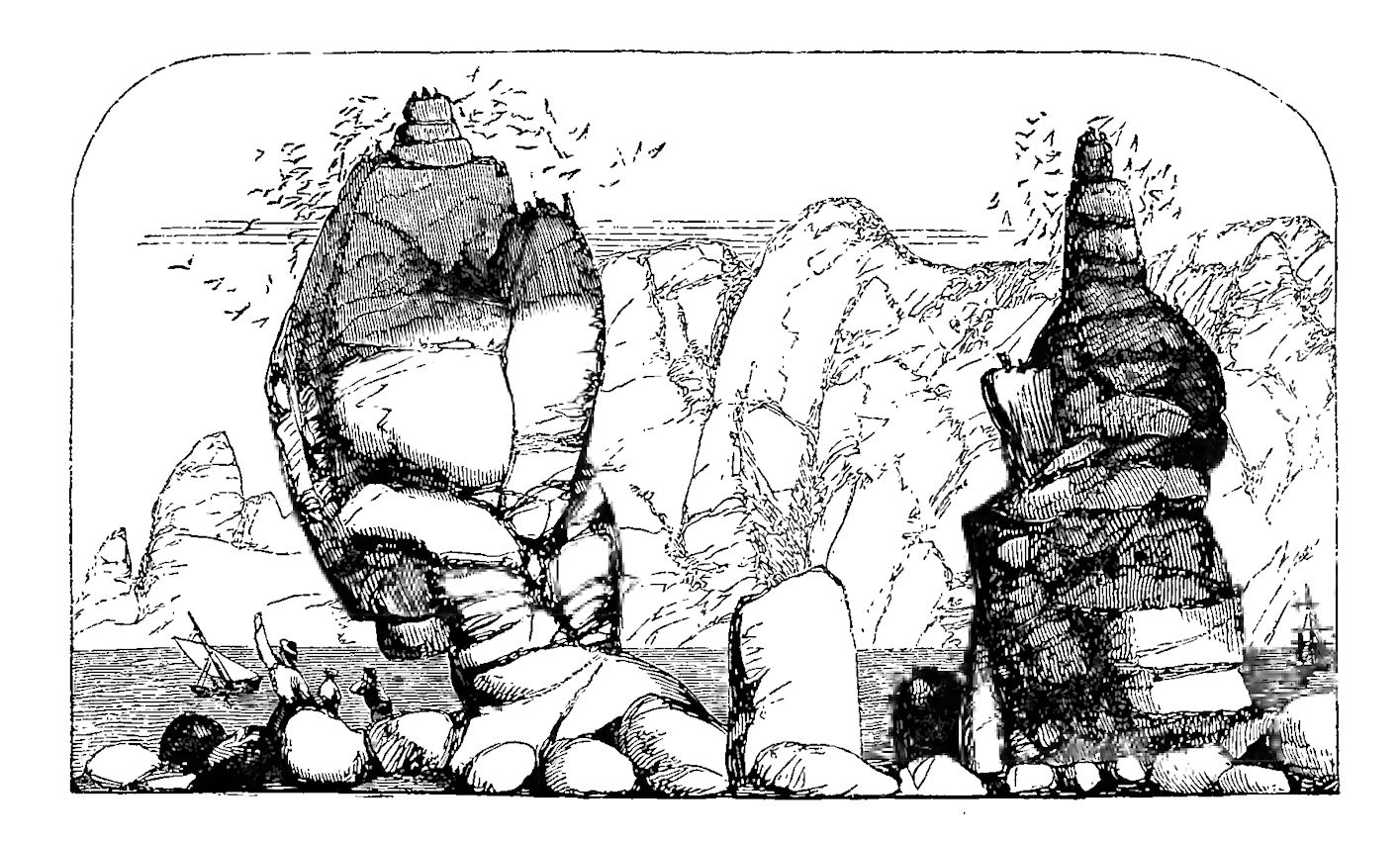
LES AUTELETS
Ascending the ledge to the eastern side of the Corbie
du Nez or Grin, we come abruptly on a yawning cleft
that nearly isolates the cape itself. Its aspect is formidable
but its descent is easy, and it leads down to the
mouth or funnel of the largest cave in the islet, La
Boutique, par excellence. To reach an inner cave a
barrier must be mounted. At high water, the billows,
after dashing on the shore cliff, rush in with a thundering
sound at two chasms on the north and west. At low
water the inner boutique may be entered with a light; it
is lofty, and on its surface there are a few stalactitic
droppings and a sprinkling of ferns. There are smaller
caverns in the cliffs. We come out on the broad bay of
Banquette, and in the little cave to southward stand
out in the most fantastic beauty the finest outlying rocks
in the islet, Les Autelets—little altars: in complete contrast,
however, one being a stupendous cube of Grauwacke
on a very narrow base, the other a huge pyramid,
on the ledges of which a flight of choughs and shags
settle and roost in the evening. The overhanging cliffs
are nearly perpendicular, and along their base lie around
in heaps the most gigantic blocks of very variegated
stones, black, red and grey; and unlike the angular blocks
on the hills they are mathematically rounded off by the
attrition of the waves. Among these rocks are deep pools
of water, in which we may discover small crustacea, and
rich varieties of the daisy actinia, the nereis, and
holothuria, and other anthozoa. There is one flaunting
in bright orange, and yonder crawls the hermit crab
that seems to have perforated an actinia within a shell,
the tissue of the anemone forming a ring round the
crab. Many of the blocks are richly clothed with fucus
spiralis (bladdervraich) and crithmum (samphire) in
all their splendour of gold and bronze. We must be
wary, however, in paddling over these slippery carpets, a
fall from them is not a trifle. Chondrus membranifolius,
and pink and green polysyphonia and dasya are
hanging on the cliffs, and the ulva and porphyra, oyster-green,
and purple laver on the deeper rocks. The blocks
are studded with minute univalves, and the patella
shells of the limpet show like bosses on a shield.
Through a splendid arch of dark reddish sienite,
marked by horizontal lines of schist, standing nobly out
from the cliff, we pass into the next bay, the most magnificent
in Serque, Porte Meullin. It is a deep wide
cave, overfrowned by cliffs of clay shale 300 feet high,
that come down perpendicularly on the beach. On their
sides and brow zigzags are cut, by which the summit is
gained, and from it we look down on the most splendid
grouping of the islet. A cleft on the south side of Port
Meullin sets off an isolated rock of very quaint form,
and leads to another fine cave with chaotic blocks and
pools, a lofty pinnacle towering above the cleft, and a
wide cavern yawning in the islet rock. These rocks are
bronzed by masses of golden gelatine, laminaria bulbosa,
and fucus canaliculatus.
Among these ferruginous blocks, talc and asbestos
and agate chalcedony, green, red, and yellow jasper may
be discovered, and veins of lapis ollaris running across
the islet.
During the western gales—and we now encountered
one of the most determined violence—the waves roll
into Port Meullin a profusion of the most magnificent
algæ or weeds that we have beheld. In a few
minutes we selected and displayed on the pebbles half
a score of splendid specimens, a complete museum of
sea treasure. There was a gigantic flag, six yards long,
of rich sienna brown with a fringe of pink, covered
with white spots, laminaria saccharina, or sea hanger.
There were the fleshy fans of nitrophyllum; long brown
ribbon slips six or eight in a bunch, asperococcus and
rhodomenia; bunches of golden pods or bladders at the
end of narrow leaves, fucus spiralis; huge bunches of
broad reddish leaves, like those of the oak, delesseria
sanguinea; eight or ten ribbon thongs, six feet long, on
a thick brown stem, laminaria digitata (they might be
a cat-o’-nine-tails for the backs of the Nereids); filigree
weeds of the purest pink and white, polysyphonia and
dasya; very long, tough, gelatinous brown thongs in a
bow, chorda filum, sea whip-lash, and the purple iridea.
The heath brows over this lane are clothed in corresponding
luxuriance. There were at least three species
of erica, a profusion of spurges, aspidia, and asplenia
ferns; ophioglossum, adder’s-tongue, and an adiantum,
maiden-hair fern, and dwarf polypodium were springing
from the stunted stems, and little tufts, like codium
bursæ, green purse-moss, and all these among clumps of
thrift and chicory, and dwarf thistles, and wild sage and
spinach, and vaccinia. We could not light on the
stramonium, wormwood, or canna indica, which we were
told now grew wild in the islet.
Couleur de rose will ever gild our memory of Port
Meullin. It was the scene of our first grand impression
of the extreme beauty of Serque; but it was gilded by a
sentiment somewhat beyond mere admiration. From
another point, a very courteous gentleman left his islet
villa, and his lady and his luncheon, and guided us to
the descent, where a bevy of fair girls, in all the romance
of elegant deshabille, were gathering weed and pebbles
among the rocks. Charming! Look across from Port
Meullin to Havre Gosselin; there is a green fissure in the
cliff 200 feet in height, as if the rocks had quarrelled
and fallen away from each other—it is the Moie du
Mouton, and along it sheep are lifted to browse on the
green down above.
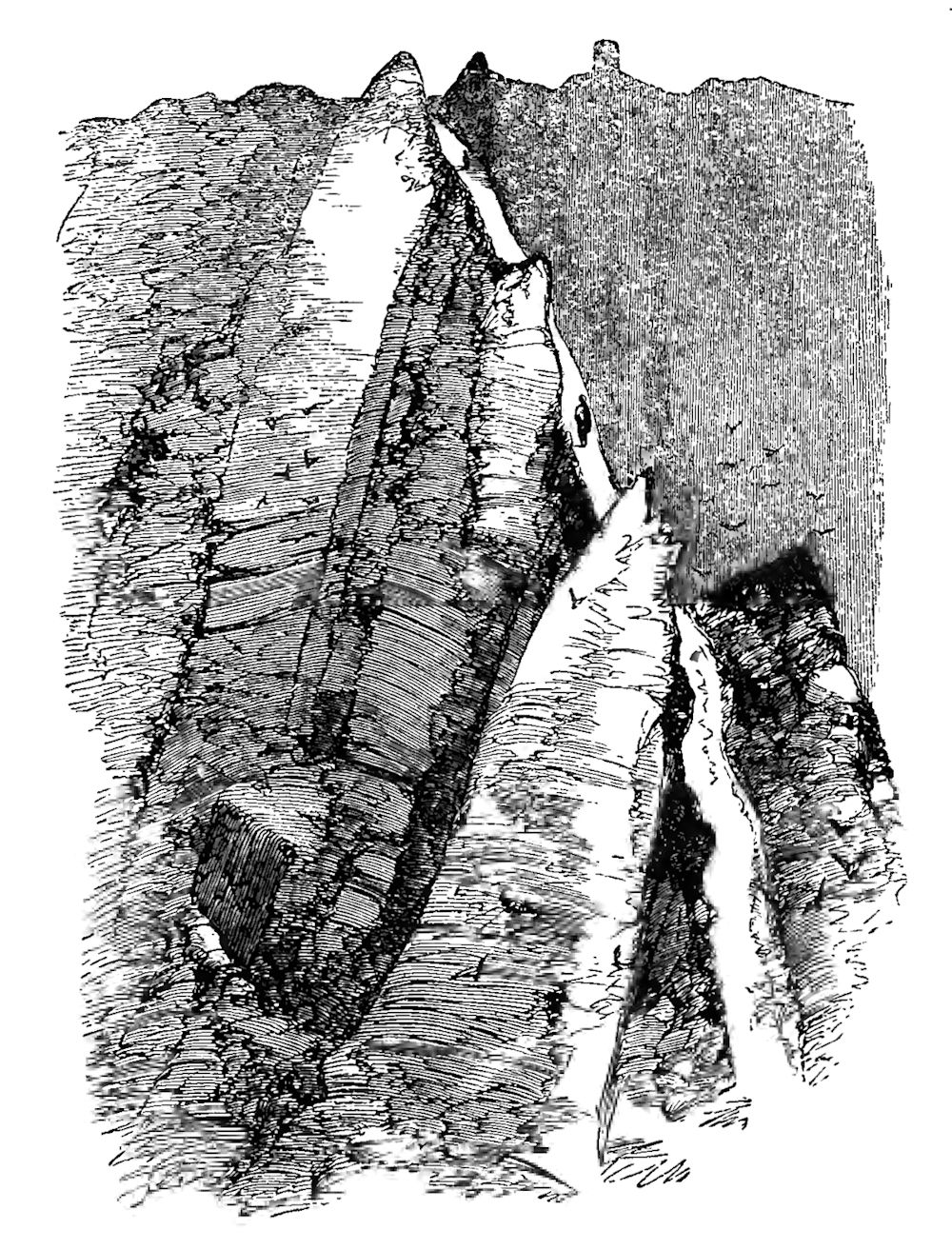
LA COUPÉ
And there on the right stretches the bold isolated rock,
Brechou, or L’Isle de Merchant, a table of rich mould
on a belt of flat rock. On its southern side yawns a
very lofty chasm. We longed to pore into it; but the
currents daunted even the boatmen of Serque. Round
the point of Lionee opens the wide bay of Le Grand Grève,
divided from the opposite bay by that most eccentric
wall of rock 200 feet high and 6 feet thick on its ridge.
This coupée, thus pared down for safety and for traffic, is
chiefly of sienite or hornblende granite, traversed by a
vein of porcelain clay, and it divides the islet into Great
and Little Serk. This, perhaps prudent cutting down, has,
however, shorn the guide-books of the high-flown
epithets of “awe” and “terror,” which they affirm must
strike the adventurer from Great to Little Serk. This
peninsula, presq’île du petit Serque—wears a dreary
aspect on its face; yet parterres of the most splendid
ericas here and there adorn its soil—a little nest of cots
and some scattered ruins of miners’ huts display a
curious contrast of vitality and desertion. The southern
point is the mining district; and though they have quite
abandoned the search for ore, the superficial barrenness
is perfectly consistent with mineral impregnation below.
Our research for mollusca was more fertile in the pools
about the southern point than elsewhere. As we round
the point we come on a little bay, the avant courier of a
splendid succession of coves and clefts on the eastern
coast, and lying off this southern point peers up the bold
rock L’Etat du Serq. Every brow on this deeply indented
shore should be rounded and scaled and descended, as far
as the worn or stony path can be traced, and then we
look directly on the face of the cliff and into the caverns.
There is one cave especially, called, we believe, Le Pot,
as fine as can be imagined—the boldest feature of Little
Serk, and on these rock-brows the lichens are in beautiful
profusion, and the grey and yellow cetraria, and the
fleshy sycophorus deformis.
We now come round to the eastern cliff of Coupée
Bay, its extraordinary wall lifting up its causeway
almost in the clouds. Beyond, the next headland opens
on us the fine bay of Baleine, or Dixcard, the holiday
spot of the islet. It is carpeted by white sand, on
which small boats may be pushed in calm weather; it is
the bathing-place of the visitors, whose half-mile walk
from the hotel is chiefly on the greensward, and there is
an arched cave in a pinnacle for our disrobing. Every
step on this bold shore displays a fresh picture.
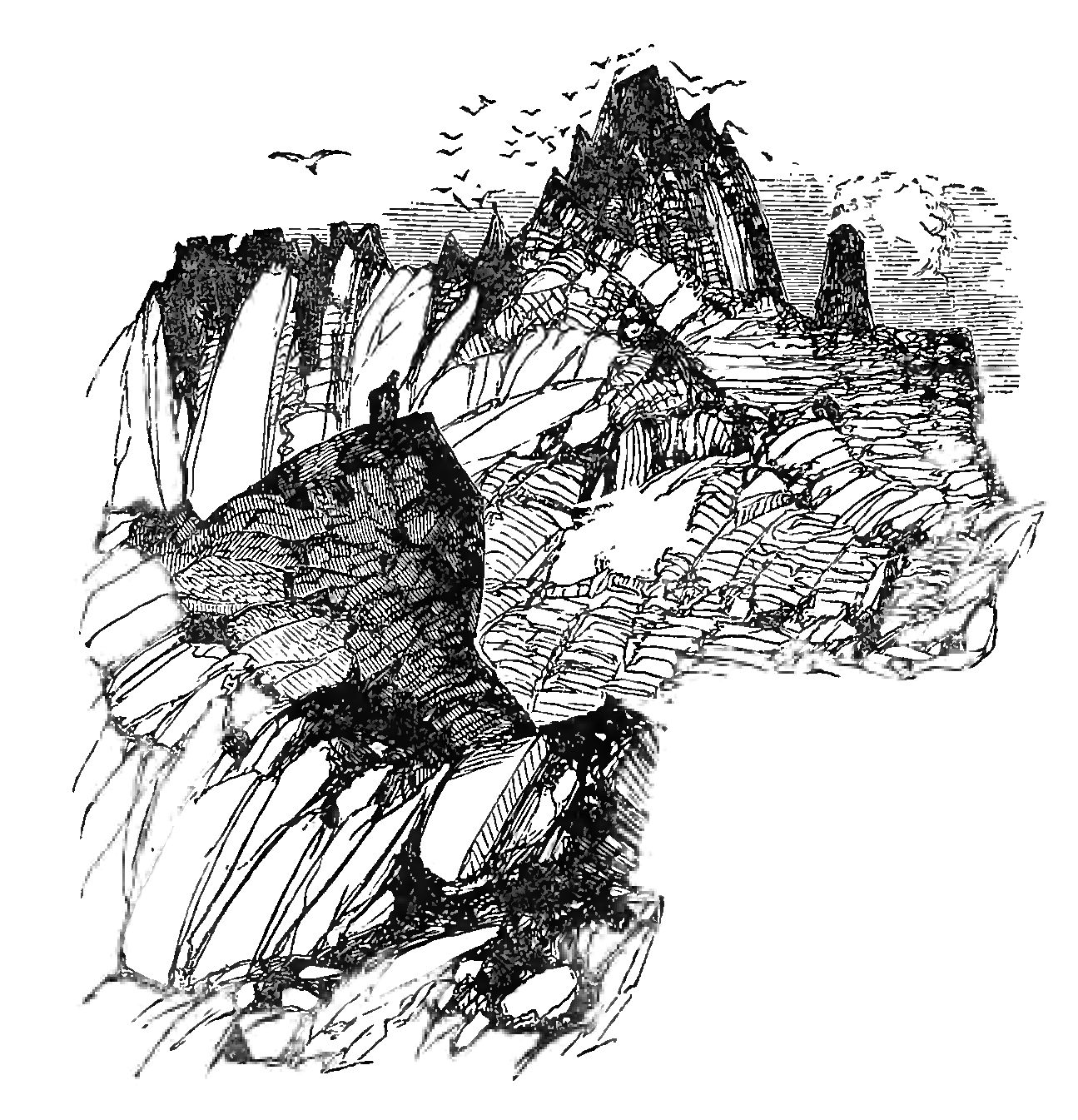
POINT VIGNETTE
Le Creux cavern, a great hole 100 feet deep, and opening
above on the hill, yawns on the beach. At high-water a
boat can be pushed into this cauldron, which is a perfect
miniature of the famed Buller of Buchan in Scotland.
Point Vignette, La Terrible, or La Conchée, lifts its proud
pinnacles beyond this. Les Burons and La Moie lie off
the cliffs. Then comes a black ridge, looking like porphyry,
termed, we believe, La Chateau. It bounds the
only little cave, L’Eperquerie—Paregorois—Port Gourey,
in which boats may be sheltered and moored. Into this
caverned cave of green velvet it was our fortune to descend
during one of the severest gales, the rolling foam beautifully
contrasting with the black-green rocks. The small
boats were dancing high on the liquid mountain, and even
the cutters and a lugger were rocking and dipping their
bows in the water, and yet at the time the water in this cave,
and in Creux also, was the calmest around the islet. The
group of fishermen below us on a rock-ledge were seemingly
in dilemma for ourselves. It was a most perilous
footing; so boisterous was the blast around the rocks, that
we were compelled to cling to the rocks, and several of
our hapless sketches were wafted aloft in a moment. The
sailors seemed to think us wild, and to wonder how and
whence we came, and, indeed, why we came at all; and
yet this was what we hoped to see—a calm would have
tamed the scene down to insignificance. Close to the
landing-place and the off-lying rock it is all perfect
studies. We have La Chapel de Meuve, a square block
of pendant granite, as if momentarily about to fall. The
range of rocks on the eastern coast consist chiefly of
sienite. We have now well-nigh rounded the islet of
Serk, a complete embarras de richesse; one glimpse
of these rocks taken at random were worth a day’s
journey.
Hark! amid the howling of the wind there is the scrape
of a fiddle—shade of Straduarius, a cremona in Serk!
A band of wandering minstrels are wind-bound in the
islet, and in sympathy they are about to invoke Terpsichore
in a stable-loft, approached by a narrow mud
path, beneath a dripping hedge and a muck-heap! And
there is the fair, the fairest maid in Serk, Fanny, of whom
it is the fashion to talk, flirting in very accomplished style,
raising flames of jealousy among the juveniles who resort
to Mrs. Hizzlehurst’s hotel. It was a very fair bit of
romantic burlesque, and took.
We are in Serk four days more than we had contemplated;
the pressure of harvest binds us in the islet;
all hands to the sickle and the sheaf. Boreas, however,
had the credit of our imprisonment; yet we regret it not—almost
every waking hour was passed in contemplation
of some fresh beauty. The bracing breeze of health, the
complete retirement—solitude, if you will—the absence
of all mere holiday intrusion, the instant transition from
our hostelry into the midst of romantic beauty, to be
admired or studied as the fit may work, and, withal, the
order of domestic economy, all mark this little islet as
the perfect home of the student who is reading or writing—of
the romantic wanderer—of the artist—of the geologist—of
all, indeed, who love to revel in wild and unspoliated
nature.
Adieu! beautiful Sark, we shall not soon forget your
perfection; adieu! for yonder lies the “Lady” of the
islet, in whose bosom we are to be wafted off to Guernsey
with the market-people who wend to St. Peter’s Port
to replenish the exhausted stores of the islet. Romance
itself must be fed, it cannot live on flowers: and so, at
five in the morning, in bright moonlight, amid a bevy of
visitors and a group of Serquois peasants, we have
passed the portal of the rocks, and wait on the beach to
be rowed to the cutter in the cove—wind, tide, and currents
dead against us; so, to gain an offing, we make
the tour of the island, and by a long tack of three miles
run up the Great Russell and round Castle Cornet into
the haven of Sarnia.
And now, still further southward, we are nearing the
fairest islet of the Channel, and after the circuitous
struggles of our voyage from Serque, with all the charm
of contrast, we overcome time and space with almost a
certainty of progression. We chuckle at this triumph
of vapour over the gales, yet with time to spare, and
with wind and tide and current in our favour—a very
rare coincidence in the Channel seas—we would yet
prefer to hoist our canvas, and skim leisurely over the
glittering waves to Jersey.
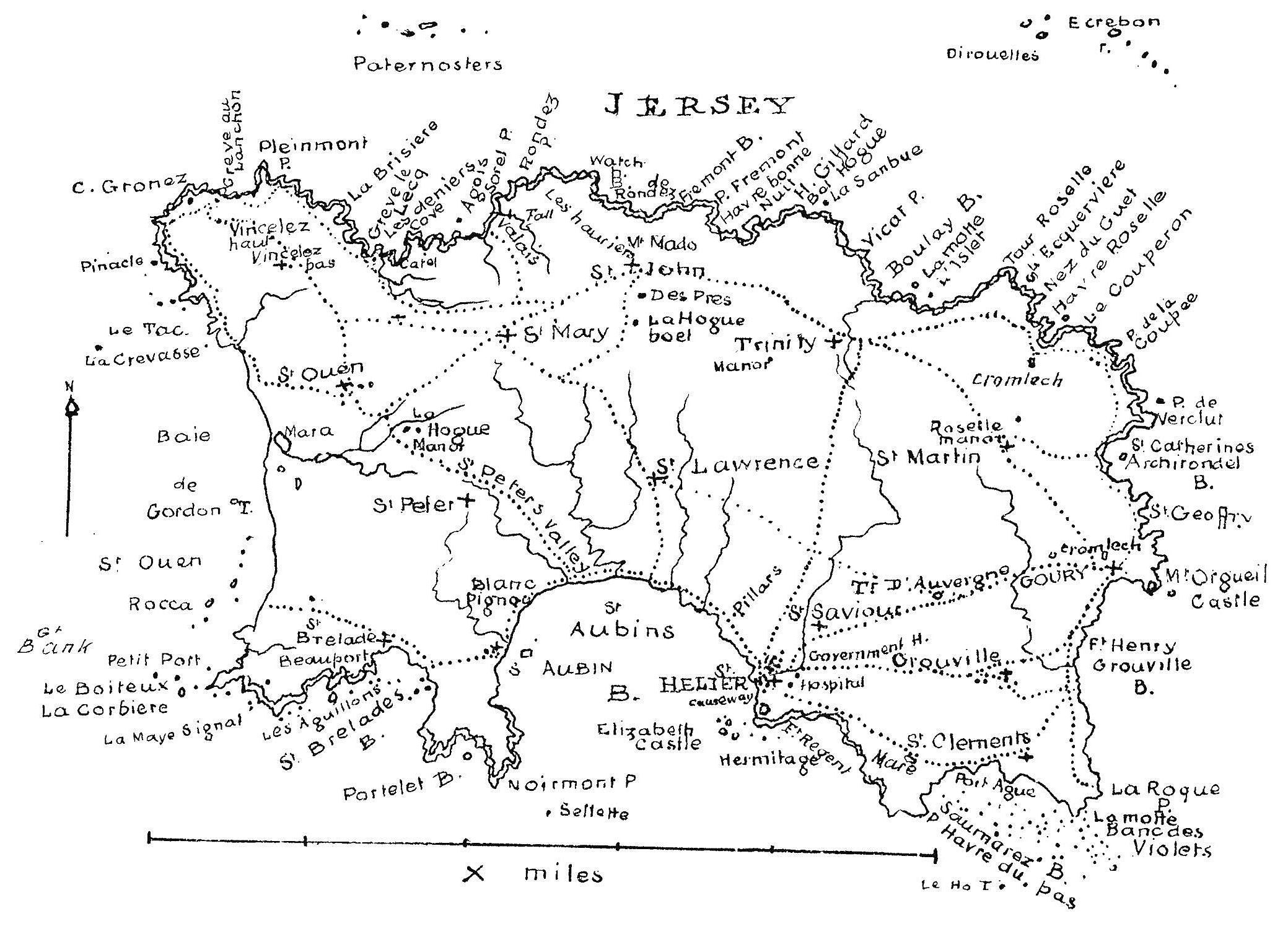
JERSEY
JERSEY:
cæsarea—augia—jarsary—jereseye—gersey—gersui—gearsey—la
deroute—dearsi (Gaelic)
We have rounded the south-western point of the islet,
and are floating into the wide bright bay of St. Aubin’s,
steering by the western passage through the narrows
between the bold fortress of Elizabeth Castle and the
pier, and we wend at once to our hostelry at St.
Helier’s.
This Jersey is an oblong islet, about twelve miles
from east to west, by about seven or eight from north to
south, extending from the Points of Sorell and of Noirmont,
and those of Belle Hogue and Du Pas. It is
completely escalloped by bays and coves and ravines,
with their essential rocks and promontories, and belted
with myriads of outlying rocklets of very eccentric
forms, composed chiefly of sienite and porphyry. The
five Points on the south coast—Corbière, Moye, Noirmont,
Le Nez, and La Roque, being nearly in the same
latitude. To these natural bulwarks the art of defence
has added a circle of martello towers around the coast,
and these are now so completely dismantled as even to
embellish and add interest to the landscape; for they
seem to tell of deeds and people of a feudal age, like the
Border peels of the north. The three great bays of
St. Ouen, St. Aubin, and Grouville, form the flat
shores of the islet.
The area of the islet is about 40,000 acres; its population
about 37,000. It is divided into twelve parishes—St.
Helier’s, St. Lawrence, St. Peter’s, St. Brelade, St.
Ouen, St. John, St. Mary, Trinity, St. Martin, St. Saviour,
St. Clement, Grouville—and subdivided into about
forty vintaines, an area containing twenty houses.
From each of these churches, which were held sacred as
a sanctuary, there was in ancient times a direct road—Perquages—to
the coast, by which the criminal might
escape unscathed if he kept the direct line.
And these are the chief officers of the islet:—The military
lieutenant-governor, the baillie, and the dean, appointed
by the sovereign; the advocate, selected by the
baillie, and the twelve judges, by the people.
As we step on the quay of St. Helier’s, or “town,” we
look on quaint grey houses assuming a Norman aspect;
but as we proceed to the interior we are reminded of an
English market-town, with neat shops and new wine-houses.
There are about 1000 houses in the town; its
population being about 30,000.
In the royal square is the court-house, La Cohue, of
the date of 1647, around which we meet loungers and
gossips, especially during the sittings, and in the centre
is a royal statue.
The public library was erected by Falle, the historian
of Jersey, and contains a very fair batch of literature,
and also the drawings of Capelin, a native artist.
There is a new prison, and a hospital, and a poorhouse.
St. Helier’s is prolific of temples of worship. Amidst
French Protestant and Catholic fanes and conventicles,
stands pre-eminent in the royal square the mother Church,
500 years old, and of pure Norman style,—a new aisle,
in perfect harmony, being lately added. Very grotesque
gargouilles and a profusion of ivy mark it as a very
eccentric pile. The government stall and pulpit are
ancient, and there are monuments and slabs to the
memory of Carterets in 1767—Durel, Dauvergues, Gordon,
and Pierson, the defender. The gallery stairs are
outside the walls. The evening is devoted to the French
service.
The several market-places, especially on Saturdays,
are scenes of very lively interest. The produce of the
Jersey gardens is most prolific, and sold at a moderate
price. The grapes are pre-eminent, and the Chaumontelle
pear has nearly attained the weight of one pound, and
is often sold at five guineas per hundred. In the afternoon
the market is a sort of fashion; but the grouping
of the buyers and the loungers is not picturesque, the
costume being chiefly the formal cut of England, or the
sombre colours of Normandy. The colloquial language
is a mingling of French and English: the children are
taught both, but, whether in truth or in courtesy, several
assured us that they preferred the English.
The votary of mere pleasure or the excitement of
gaiety, must not sojourn in Jersey: out of the pale of
select society St. Helier’s will be most monotonous; it
will be indeed a complete blank, and he will quietly fly
off to scenes more exciting though infinitely less healthful
and happy, leaving beautiful Jersey to us, to those
whom the Deity has endowed with a deeper feeling for
the charms of Nature’s loveliness.
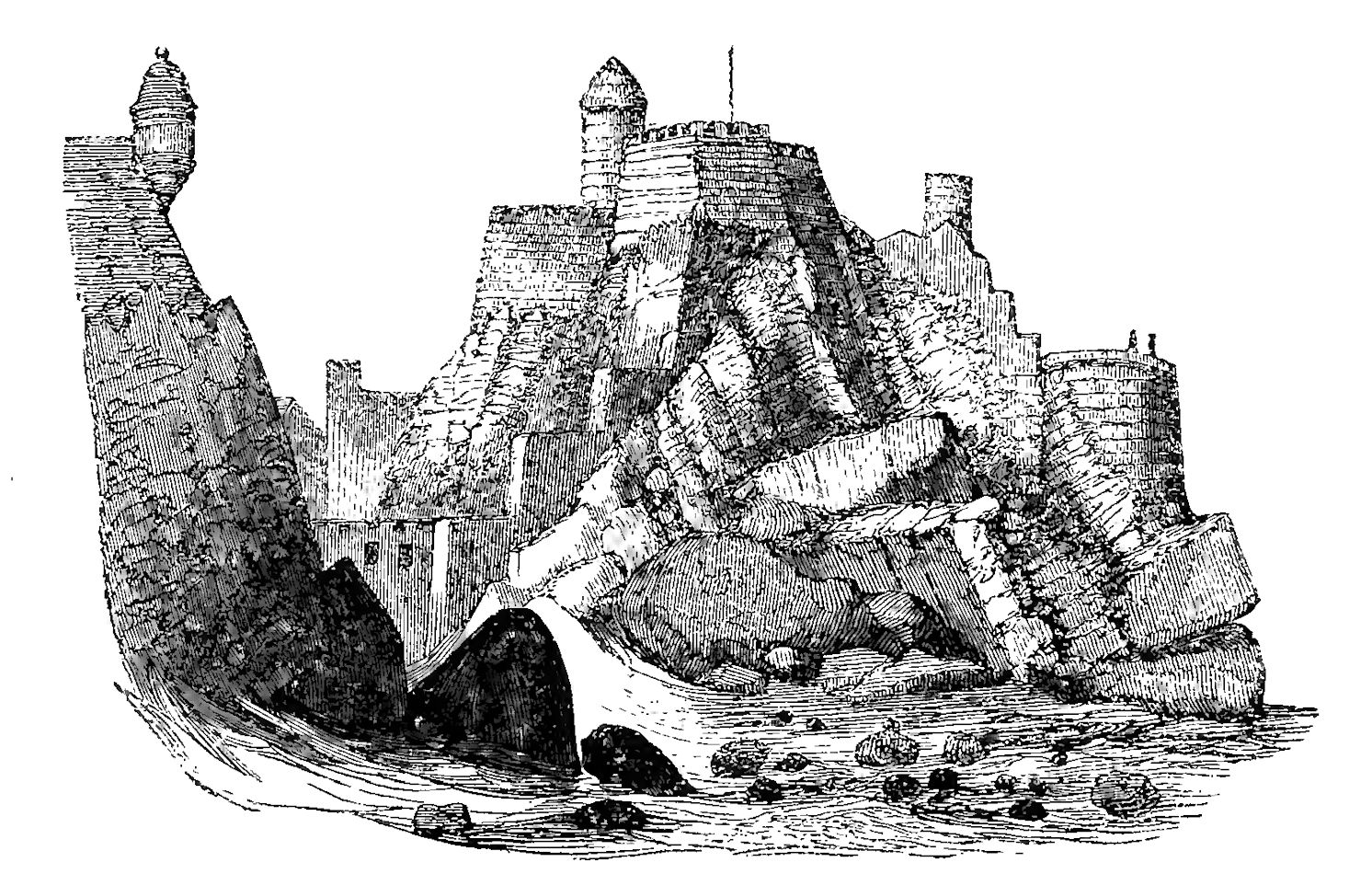
ELIZABETH CASTLE, JERSEY
The visitation of the ancient and modern works around
St. Helier’s is worth a day even to the superficial gazer.
The eye of the archæologist and the artist is attracted at
once by the bold fortress of Elizabeth Castle, isolated at
high tide, but approached at low-water on the floor of
the bay. Along a causeway track from the “Black rock,”
on the shore, we wend with market-women at our heels,
and meet a company of soldiers marching on some duty
to St. Helier’s. We must not linger in our survey, as
the tide will flow in four or five hours, often to the
height of forty feet.
The castle stands amidst a group of schist rocks,
about a mile in circumference. One of the outermost
blocks is crowned by the remnant of a real hermitage,
the cell of St. Helier, who was murdered in the ninth
century by a band of Norman pirates.
The access to the stronghold is intricate and well
planned for safety and defence. It was built in the
seventeenth century. Amidst a profusion of modern
and debasing architecture, look on the very curious gate-arch,
on the ascent to the keep. Above a fleur-de-lis at
the point of the ogee of the arch is an escutcheon in
stone—the royal shield of Britain, crested by the red
and white roses. Over the left feet of the supporters are
the initials, E. R., of the maiden Queen, in whose reign
the first stone was laid. On one of the arches is a circular
disc, displaying daggers and a fret. To this keep
Charles II., when Prince of Wales, fled for refuge, with
his brother James and Clarendon, the islet of Jersey
having declared for him, while Guernsey sided with the
Parliament; and here Charles drew a new map of the
island, and Clarendon penned part of his celebrated record
of the Rebellion. In gratitude for its loyalty the King
presented them with a gilt mace on the Restoration, and
graced it with a Latin inscription.
Across a deeper water opens the capacious harbour,
with its two piers, Victoria and Albert, which, especially
in storm and tempest, is often crowded with vessels.
The basins were now nearly destitute of craft; but
acephalæ are floating around the piers. Crowning the
high greenstone ridge above it, Mont de la Ville, is
Fort Regent, a fortress, erected at the cost of a million,
of stone from the quarry of Medo, on the northern
coast. Its area is about four acres. It is bomb-proof,
and commands completely the bay and the town. The
view from its height compasses the bay of St. Aubin, the
government house, the college, a mansion of modern
Gothic, erected in 1846, after the Queen’s visit, and the
south-eastern corner around St. Clement’s and Grouville,
the Banc des Violets displaying a strange group of
black blocks among the surf waves. At low tide the
bay is a wide stone basin, carpeted with rock and weed.
As we looked on it at high water, in an autumn sunset,
it was a mirror of liquid amethyst.
On the brows around St. Helier’s many Druidical
stones and tumuli have been discovered. The chief
cairn, or Poquelaye, very complete, with its circle and
alley, was revealed in 1785. It was removed entire by
General Conway to Park Place at Henley.
And now there are three classes of subjects that are to
be admired and studied in Jersey—the magnificent cliffs,
the beautiful bays, and the fair natural garden of the
interior, taking up the archæological relics in our way as
choice morceaux of historic illustration, adding an interest
even to the face of Nature.
In our visitation of the bay and the cliffs we thread the
lanes and valleys, scenes of very contrasted excellence,
like the picture of a fair beauty within a richly-carved
frame. The scenic grandeur of Jersey is between Le Tac
and La Coupé, the whole northern coast of the islet, and
at the south-eastern corner, from Noirmont to La Rocca
in St. Ouen’s, all exquisitely rich in rockwork. The coast
from St. Helier’s to Gourey is a mass of button rocks.
In the interior St. Peter’s displays the only Devonian
valley. But throughout the islet there are very lovely
spots, like those of Kent and Surrey, for our rambling,
amid meadows enlivened by tethered cows and green
hedge-rows, enamelled with flowers, often rich and rare,
on which bees luxuriate and gather their luscious stores
of honey, and dingles (the Val des Vaux is close to
“Town”) feathered with petit, though very luxuriant
foliage; but there are no gigantic woods of oak or beech
frowning from uplands of chalk or sand. The descent
to the caves, however, opens all around us, often with
the heightening charm of unexpectedness, dingles of
surpassing beauty, as wild as we can wish them. And
to all this, the mere holiday folk may be wafted along
the military roads of General Don, and they may be
lifted from St. Helier’s to St. Aubin’s and to Gourey in
public coaches. We, who come to woo Nature—for we
love her with all the pure idolatry of a Thomson or a
Davy—select the bye-lanes and the meadow paths. Yet
even here we loiter not, although these garden meads of
Jersey are the very choicest spots for the secluded rambles
of lovers and the joyous festa of gipsying, especially
when the warm south-west blows over the Atlantic.
But running water is well-nigh a blank in Jersey.
As in all small islets, the rivulets are quiet little runnels
rippling down from springs on the northern brow, and
stealing south straight into the bays; the gulleys of
Grève le Lecq and Boullay creeping northward. Here
and there the runnels turn a little mill-wheel; and then,
in our walks, we often stumble on an old church, and
also on a venerable manor-house, of which there are
about half a score in Jersey, St. Ouen’s, Rosell, La Hogue
Boëte, &c. And now to compass the beauty of Jersey.
The walks should be around and across the south-west
and south-east corners, from Town to La Corbière, and
to Gourey, the northern coast from Le Tac to St. John’s,
and thence to St. Martin’s. A pony may carry us to
any of the northern villes, from which we may reach the
magnificent points of the northern coast, or a carriage
may take us along the Devonian valley of St. Peter’s to
St. Ouen’s, and await us at St. Martin’s, to bring us back
to St. Helier’s, and, in this lovely valley of St. Peter’s,
if we are fond of cryptogamic botany, let us thread the
bosky cliffs of the glen, and on the stems of the wild rose
find the finest tufts of the beautiful golden lichen, Borrera
chrysophthalma.
High and low water display contrasted aspects, both
equally perfect. At high tide, the full bays and havens,
like gigantic mirrors, are resplendent with the reflection
of their beautiful shores.
To the botanist, the geologist, and even the artist, low
water is far more propitious, for the beach, cliffs, and
rocks are profuse in weed and sea-flowers and pebbles
and shells, and they thus give up their treasures for the
seeking; the outlines and colours present a perfect charm
for the pencil.
Let us be off in pursuit of these temptations, scramble
among the rocks, creep round the bays, or into the caves;
for, like the violet, much of the more enduring beauty
of the creation lies hid in the deep shades of the earth.
We are about to make the circuit of the islet. It is
high water, and we float over the wide bay to St. Aubin’s,
or to Noirmont. It is low tide, and we walk round the
shore of this marine crescent on the firm carpet of sand.
(At a tiny rill at Doet de Demigrave there is a very
sudden transition from firm to soft.) There a group of
girls are disporting like Nereids among the waves. It
is at full tide, and at evening hour, however, that the bay
of St. Aubin’s is perfect to the eye; the setting sun is
flinging the most gorgeous colours on the little slate
rocks and the walls of the fort: the hue is gold, with a
shadow of bronze, while the more distant walls of Elizabeth
Castle are bronze with shadows of deep grey, a
scene special for the eccentric brush of Turner.
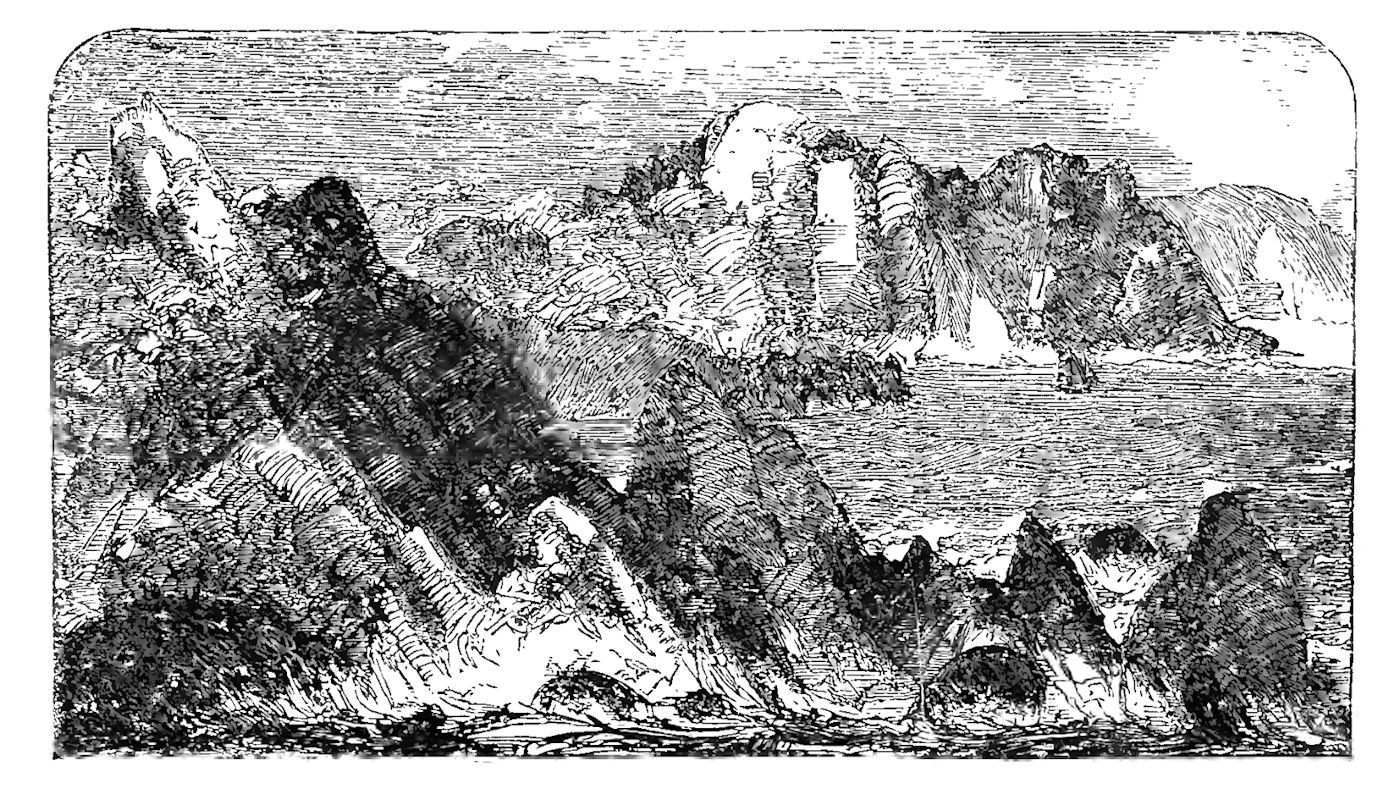
ST. BRELADE’S BAY
From the brow over St. Aubin’s the view is splendid,
overlooking the now poor, yet neat and secluded little
village town, its petty haven, and its castle. We are at
the entrance of a richly wooded glen, leading up to the
peninsular hill (on which stands a tolmen stone), that
dips southward to Noirmont, a ridge formed of sienite,
rose feldspar, and thallite, striated at the point; ay,
and we may gather a wallet-full of ferns—and there is
one very rare, if not quite unknown, in England, gynogramma
leptophylla. We may creep round the secluded
Portelet Bay (enlivened by the Janerim towers or martello)
from Noirmont to Point la Frette, or descend from
the brow to the broad bright bay of St. Brelade’s, divided
by a red rock ledge into two; the cliffs and rocks
come out in great splendour, and the out-crops of the
sienite groups on the hills are in the finest style. One
enormous mass of blocks is a perfect specimen of Titanic
arrangement; it looks primeval, antediluvian. It is
richly covered by grey and yellow lichen, and deeply
festooned with ivy and clematis, amidst the most luxuriant
variety of heath-flowers, pink and deep purple,
blended with the bright golden pods and deep green of
the mountain furze. Around it are the green tufts of
the protonoma moss and the adiantum, or maiden-hair
fern, and myriads of the dwarf rose d’amour are studding
the turf, and amidst all this floral profusion green lizards
are creeping stealthily, their eyelets sparkling like diamond
points amid the leaves—a perfect study for a Pre-Raphaelite.
From the hills we descend to the white
hard-soft sand around the crescent bay—it is a luxury
to step on it.
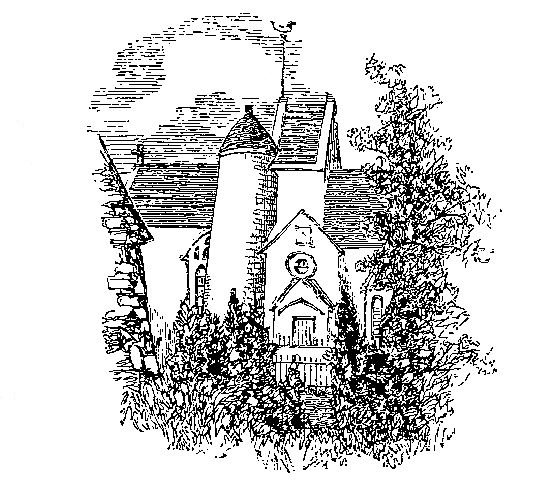
ST. BRELADE’S CHURCH
The gem of St. Brelade’s is its very quaint little
church, the parish fane of St. Aubin’s. It is perched on
the edge of the Rock cliff, overwashed by the waves at
spring tide, and surrounded by tombs and slabs on the
velvet turf, and spotted with cypress. It is of the æra of
Henry I., 1111, one of the twenty-five erected at that
period, and its history bears a very romantic legend. It
was to have been built eastward of the bay, but the
fairies of the sward removed from their realm the work
and tools of the masons for three successive nights, and
dropped them at St. Brelade’s; and at length the people,
in a panic, yet warned and directed by this deposit,
erected their church on the spot which the fairies had
thus selected. On the walls of an antique chapel the
form of Herod and the angel Gabriel are rudely figured,
and on a scroll from the mouth of the Tetrarch is inscribed,
“Herod le Roy,” and before him is the Saviour,
bearing his cross.
On the brow of La Maye is the signal-post, and off
the cove of Beauport lie the Aiguillons rocks, and off the
south-west point the rock of La Corbière, its apex
painted white for a sea-mark. From the downs the
views are complete.
An extensive district of this south-west corner, Les
Quenvais, is a record of the devastation of the hurricane
in the fifteenth century. In St. Ouen’s Bay, as in
Loughneagh, in Ireland, it is believed that ruins of
houses and walls are visible at low ebb. The village
was overwhelmed, and all the people drowned, for
decoying, by false beacons, some Spanish argosies that
then foundered on the rocks. The wreckers plundered and
plunged them into the deep. As they were by Bacchanalian
orgies celebrating the anniversary of the wreck,
the sea rolled in and overwhelmed the sinners and their
ville beneath its waves.
And there spreads out its arc of nearly three miles
the flat bay of St. Ouen, from the rock of La Corbière to
that of Le Tac, or La Crevasse. The bay shore consists
almost entirely of round hillocks of mica-quartz
sand (the relics be sure of the avenging elements), profusely
covered by long marine grasses, to the fine stems
of which myriads of tiny univalves are adhering. The
sea holly, eryngo, is in the most brilliant flowering; its
blossom, of the purest cerulean blue, may rival in Jersey
the brightest exotic of the greenhouse. The Great and
Little Sandbanks lie off the bay, and nearer are the fine
group of La Rocca, and the Gorden tower in the bight.
The quaint ancient church of St. Ouen is on the brow
and close by the venerable manor-house, and there is a
fresh-water marsh lake, La Mara. And here Sir Philip
de Carteret was fishing in the olden time, when he was
attacked by a French troop; but he escaped by leaping
his horse over a chasm near La Val de la Charriere, the
animal falling dead as he reached his home. A giant
rock stands alone at Le Tac and La Pinnacle, 100 feet
high at the extreme point, both very fine studies. A
recluse may lodge at Le Tac, almost out of the world.
The road abruptly winds from the beach over the
hill, and on the downs we are at the hamlets of Grosnez
and Vincelez. Cape Grosnez, “the great nose,” points
half a mile to the left, the boldest cliff of the islet. The
rocks are of magnificent proportions, 300 feet deep, and
almost perpendicular. The gate arch of the very ancient
castle of Grosnez, its origin believed to be Roman, and
the home of Le Carteret, in the æra of the Plantagenets,
stands alone on its green platform. From it the whole
group of islets to the north-west forms an exquisite little
picture.
From the “Stone Plank,” lying across a deep rock
ravine, a youth fell, and was washed to sea, in sight of
his friends assembled at a pic-nic.
A flash, a peal—ay, all in keeping with the scene—the
growl of thunder completely around and above us,
and the lurid gleam flings a sort of spectral halo over the
heavens. There are two intensely black clouds sailing
in contrary currents towards each other, like destroying
spirits. The flash from the Guernsey cloud charged
highly electric streams over to that from Sark. Guernsey
comes out in bright light for a moment, and then is lost.
Sark is overshadowed, and looms out like a great purple
wall, the chiselling of its cliffs and rocks, that a minute
since showed like huge bastions and gables, is totally
obscured. An awful position, if we linger here, and yet
the mise en scène is most magnificent—sublime. The
storm instantly bursts on Grosnez, and we brave its wild
fury, to look forth on a glory from which Salvator,
Loutherbourg, and Turner might have drunk in ideas
of elemental majesty. A black and murky cloud settles
round yon point of Pleinmont, a bold, caverned rock of
sharp sienite, shaking with its thunder the old fort and
drawbridge, and driving its flood across the bay of Grève
au Laucheon, and far into its caves of gloom, 400 feet
deep. One of those sudden transitions of electric storm
brings out the brightest sunbeams, and we look across
yonder rocky dingle two miles away on the beautiful
cove of Grève la Lecq, with its barrack and hostelry.
The sea is rolling gloriously at high water over the
rocks of Les Deniers, its mountains of milk-white foam
breaking on a floor of sand as white as they, and thundering
on the deep umber rocks, embossed on the surface,
and then rolling with a deeper roar into that yawning
cavern on the western cliff. Towering over the
shore of the bay hang stupendous cliffs, some 400 feet
high. From the eastern mound over the Crab Caves,
Catel de Lecq, we look up the two dingles which come
down, rich in woodland, to the bay, just about an old
grey martello: then by a mere turn on the heel we are
directly on the verge of a magnificent cave, closed in by
cliffs nearly 500 feet high, huge granite blocks strewed
around their bases, and more seaward a belt of white
sand and a beach of black pebbles. The scene is wild
and rude as the Hebrides, and where the rolling surge
on the beach meets the transient flood of a storm-cloud,
it displays a picture almost as majestic as a sea-loch in
Skye.
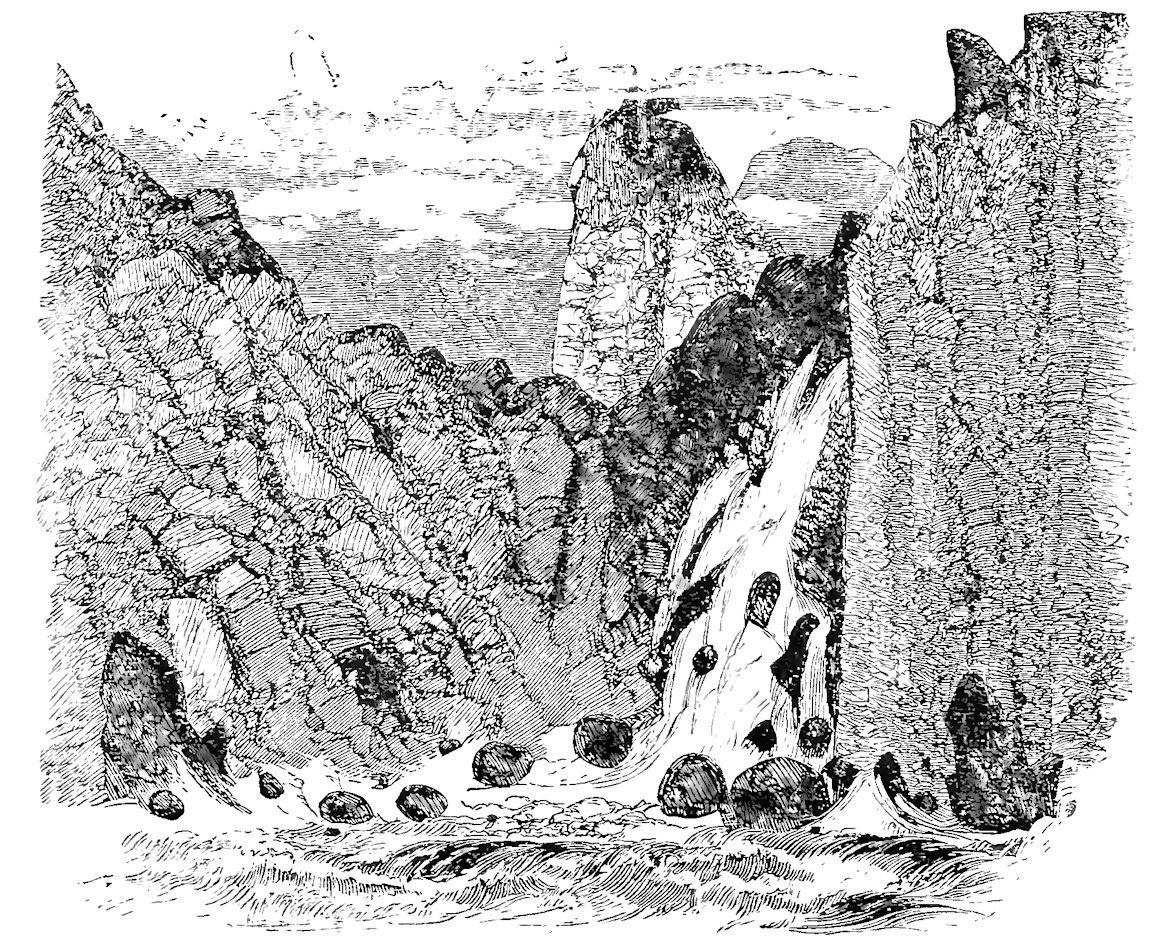
CLIFFS NEAR GRÈVE LA LECQ
On the face of the cliff yawn two deep and dark
caverns, to reach which at low water a ledge of rudest
steps has been cut diagonally on the perpendicular face
of the rock. The descent by this rock-ladder is no
puerile feat. We are halfway down, and are checked by
a block having fallen from the ledge. There was no
turning, so there we lay on the side looking down over
the perpendicular 200 feet on the black rocks in the cave.
To fall or not to fall, that was the question: if we
condescended to drop, that is, to descend rapidly, in
obedience to the primal law of gravitation, a fracture of
limb or neck was a certainty, and yet we deemed an
ascent an impossibility; so as a dernier ressort, or rather
a forlorn hope, we turned on the back, worked upwards
half on and half off the cliff, when happily a wider ledge
by six inches enabled us to turn, and then we stood
erect in proud triumph, crowing like a bantam at our
really narrow escape, and looked gratefully down on the
frowning rocks thus cheated of “an awful catastrophe.”
There is a grey kite, too, hovering noiselessly over our
head. We wave him off majestically—we are not to be
the prey of gleds and corbies be sure on’t.
Silence reigns around, a calm between the storms,
save when the sea-bird flutters screaming along, or the
beetle wheels around us his droning flight. But, hark!
again—thunder is growling like a jealous gnome at our
escape and our exalted enjoyment. Twice, indeed, we
essayed to leave this accomplished spot, and lingered
until the broad evening shadows began to deepen even
the gloom of the storm-cloud, and we descend by two
dismantled forts, their guns lying rusted on the turf.
Les Pierres du lacq—the Paternosters—high above
water on our ascent, are now lost in the deep.
The tempest was raging as we were driving down a
wooded dingle. A flash and a crash in quick succession—the
lightning has struck the rock: a huge block,
several tons in weight, rolls thundering down the precipice,
crushing trees to atoms in its downward course.
The driver of our carriage is scared from under the
boughs and dashes down the valley like a madman.
Poor fellow, he was neither a Franklin nor a Faraday;
and not reflecting that the storm-cloud travels swiftly,
he did not know that this very dingle was now the safest
place in Jersey.
The villes of St. Mary and St. John are near us;
their churches of the fourteenth and thirteenth centuries.
In St. John’s, on its saint’s eve, was once celebrated
in all its degraded perfection of orchard-robbing, cow-milking,
&c., the wild marauding game of Faire brave
les Poeles, a stain on the sporting annals of Jersey. It
is now, we hope and believe, nearly obsolete.
The coast is still bold, and there are tiny cascades on
the runnels close by, and a ruined mill somewhat picturesque.
It is on this northern coast that the scenic
contrasts of the islet are so exquisitely displayed. Not
far from the verge of a cliff 300 feet high, we are in a
leafy dingle, and look over the waters unconscious of our
height. Yonder, a mile off, are the Pierres du lacq at
low water; the front of Guernsey looming on the left,
and Serk rearing its majestic wall of sienite on the
right.
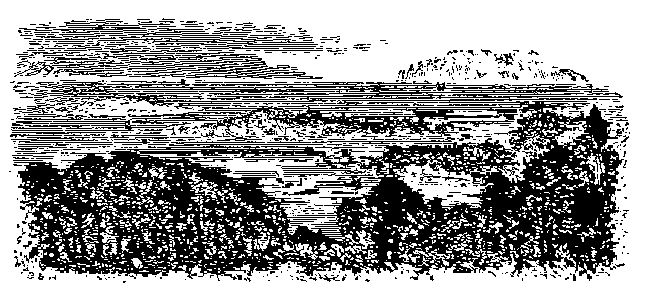
GUERNSEY AND SERK, FROM JERSEY
The granite quarries of Mount Mado are above the
coast, and near the point of Belle Hogue there is a little
twin spring of water that is believed to cure blindness,
age, and dumbness—and this is the legend of the wells.
These little founts were the tears of two fairies—for
fays feel like ordinary mortals.—Well, Arna and Aruna
were wont to gambol and to chant around the rocks of
Belle Hogue. They were at length sanctified, and wafted
to heaven by an angel; but the love of their Channel
home was still warm in their little bosoms, and once,
musing in melancholy mood on the delights of their
Belle Hogue, and fluttering with longing hearts directly
over the enchanting spot, each dropped a tear of regret
on the earth, and from them two little fountains were
instantly playing up the sparkle of their crystal drops.
From Belle Hogue to the bold round block of La
Coupé, the cliffs are of breccia, or pudding-stone; the
rest is chiefly schist, with veins of porphyry, especially
about St. Martin’s and Roselle.
Trinity lies about a mile from the shore. In the old
manor house, the home of the Carterets, are still preserved
the goblet, table, and gloves, presented by
Charles II. The lord of this manor presents two drakes
before the sovereign who may be dining in Jersey.
Descending along a fine dingle, we open the wide
bold bay of Boullay, the landing-place of Strozzi, the
invader, in 1549. The panorama, enlivened by its beacon
and its pier, is almost as beautiful as that of St. Brelade’s,
and it is belted by very splendid cliffs and rocks
of thallite, greenstone, and porphyry.
Near Le Nez du Guet are the Roman mound works
of La Petite Cæsare.
And now opens the little bay, Havre de Roselle, a
beautiful rocky basin, bounded by Le Nez du Guet and
Le Couperose, and spotted with three rocklets, and possessing
a barrack. A fine rocky dingle, between lofty
cliffs and fringed with wood, runs up into the land
towards a Druidical Poquelaye above Le Couperose and
La Coupé and the bay of Fliquet, with its tower. The
road from Roselle to Gourey is scooped in the shore rock.
Round the point of Verclut opens the bay of St. Catherine
with its insular horns of rock, and one crowned by
the tower of Archirondel. Then there is St. Geoffrey’s
rock, from which in the olden time criminals were
thrown into the sea. Roselle Manor and the ville of
St. Martin’s lie on the high ground.
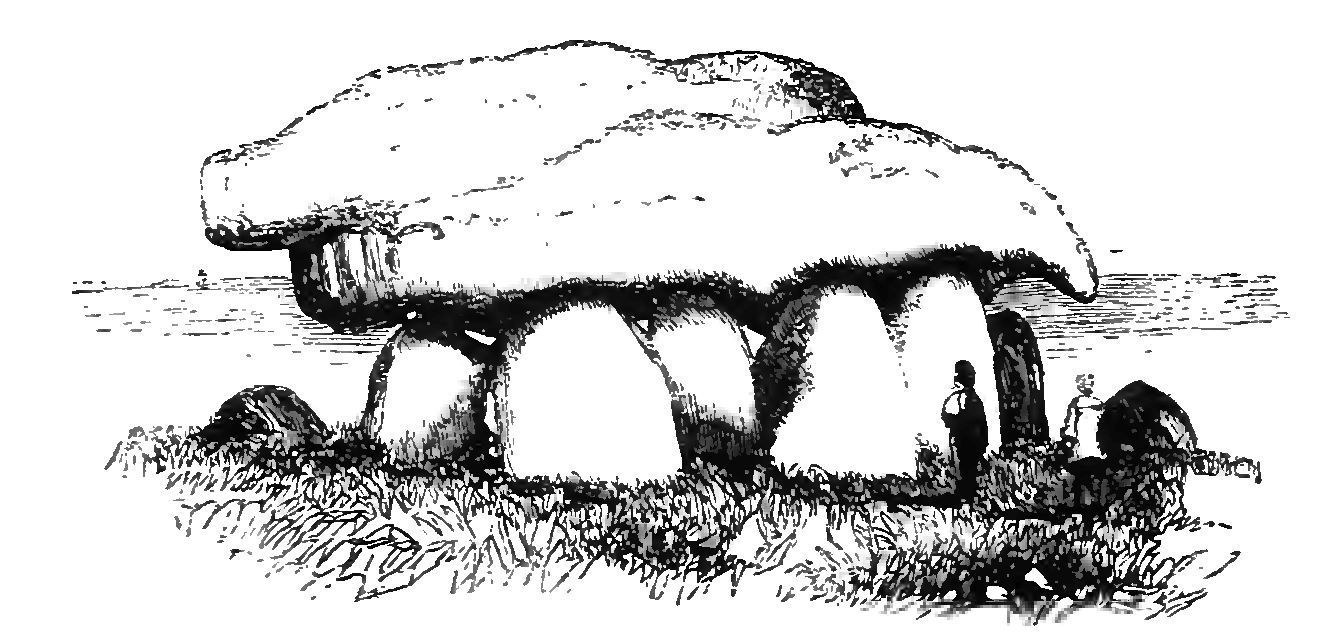
CROMLECH
Approaching Gourey, we stumbled on two most interesting
bits of antiquity. On the hill near the coast
is a very fine Poquelaye in a rough field near the warren.
An oval of twenty-one stones—fourteen within, in two
rows, supporting three large horizontals, one fifteen feet
long and ten and a half broad, and weighing eighty tons.
Near the Parc de la belle Fontaine a very quaint old
house stands in an orchard. Its turret staircase, La
Tourelle, is especially curious, but we cannot find it
described.
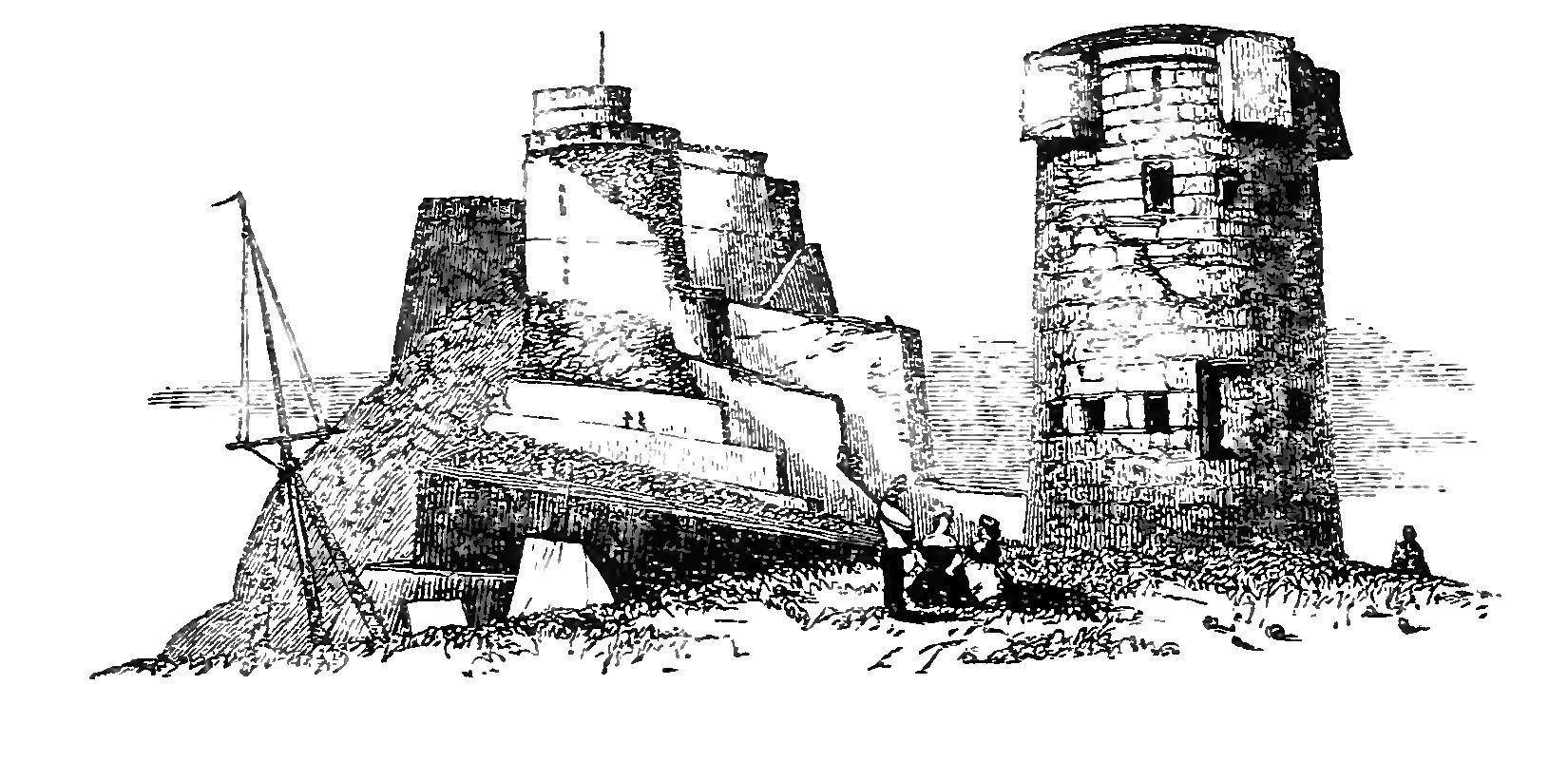
MOUNT ORGUEIL CASTLE
And here below us on a shallow bay is the quaint
little town of Gourey, the third ville of importance; its
church perched on the brow—large dark blocks lying
around its little haven—one, l’Ecquiercriere, standing
out the most eastern point of the islet. Above all, the
magnificent, though now dismantled fortress of Mount
Orgueil is towering aloft on its rock, fully illustrating
its proud title. It is a perfect subject for the pencil,
and is replete with historical associations. It was an
especial object with King John. In the reigns of Henry
VI. and Edward IV. the Count de Maulevrier seized
Mount Orgueil and half Jersey for Henry, while Carteret
of Grosnez, Seigneur of St. Ouen, held the rest for
Edward. In its dungeon were imprisoned by De Carteret
the two Bandinels; one, in trying to escape, was
killed on the rocks; the other went mad. It was the
prison of Prynne, who here wrote his thoughts and
Rhymes on the castle, which he dedicated to—
“Sweet Mistress Douce, fair Margaret,
Prime flower of the house of Carteret.”
As we mount the immense flight of steps, we come on
the door through which Charles II. passed to the cliffs
where the boat was moored that wafted him to France.
He had fled hither to Jersey from St. Mary’s in Scilly,
as more remotely secure. Near this is the crypt—one
of the most eccentric bits of antique masonry which we
have seen—and opposite is the court in which was discovered
the effigy of the Virgin Mary; and onwards
yawns the tower dungeon deep and dark. There are
Roman bits of masonry still in the walls. Near the gate
are stone benches, once the seat of judges, and close by
beams for the suspension of those whom they condemned.
From the keep the Cathedral of Coutances is distinct in
a clear atmosphere.
On the rocky beach of Grouville bay, a profusion of
vraich is often deposited. The sand hillocks are covered
by long grass, and the eryngo here blooms beautifully.
The oyster bank, for which Gourey is famous, is spread
two miles off the bay. The rocky ledge of sienite
which underlies the schist of all this south-east point
fringes the whole south-eastern angle, and is defended
by a formal range of martellos—La Roque at the
point, and Seymour tower stands in the midst of the
waves.
And near La Roque, or Rocbert, is the Rock of the
Hag, and this is the legend of the rock:—
There was a very beautiful Madeleine and there was
a young fisher named Hubert, who loved her; but he
was inveigled by the witches, and charmed into aversion
to her. The heroine in despair, with a cross in her
hand, incurred the perils of storm and billows to save
him from these spells, and as a memento of her happy
success, there is the Point du Pas, the “footstep of the
virgin,” to this day.
Then there is another large rock, once a stumbling-block
of contention between St. Magloire and the Druids.
The priests engaged the Devil to roll a block from the
shore to proselyte the people; but when they tried to
roll it back again, St. Magloire laid his holy book on it
and it was immovable; he then set the cross on the
rock, and the demon fled, the Druids succumbed, and
the immortal safety of the people was insured.
And these rocks may be discovered if one will, and
pebbles and shells may be gathered, and we may bathe
at the favourite dipping-place of Portague, or we may
ramble to the nice little church of Grouville, dated
1312.
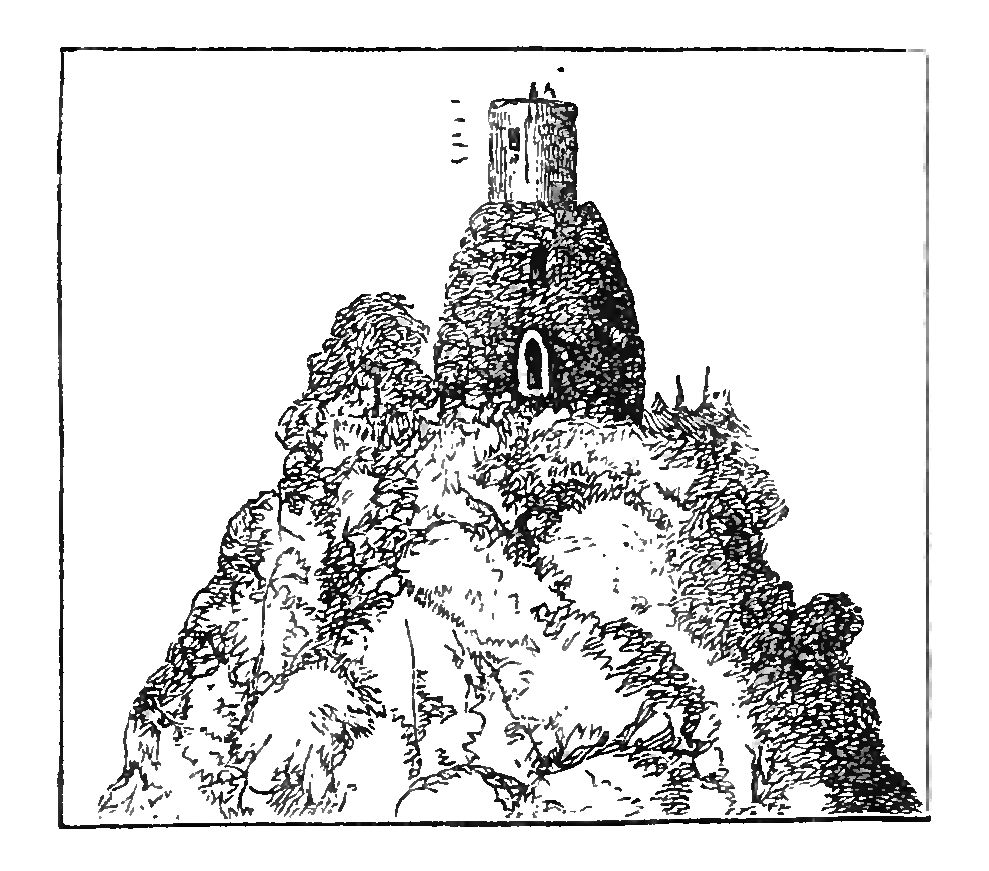
LA TOUR D'AUVERGNE
But we must not overlook the bit of antiquity about
midway between Gourey and St. Helier’s—the Prince’s
Tower, La Tour d’Auvergne, or La Hogue bie—Hogue,
mound, or monument—that crowns a mount on the most
elevated brow in the islet. It was built on the site of
an ancient chapel, on the model of the Sepulchre at
Jerusalem, and was enlarged by Mabon, Dean of Jersey,
about 1750, who, it is said, worked miracles under the
Virgin. One of its lords was the Prince de Bouillon,
an English admiral; but the legend of De Hambie, as
deep as it is obscure, is the illustrative charm of La
Hogue. This is the tale in brief:—The servant of this
De Hambie murdered his master and married the widow,
who, stung by remorse, erected this tower, visible from
her chateau at Coutances, to the memory of her dishonoured
lord. Another record refers the death of De
Hambie to the poisonous breath of a dragon which he
slew; but as even the Livre Noir of Coutances leaves
the matter undecided, we presume not to fathom the
secret.
A blind boy is our guide, who from habit points out
correctly the very richly-wooded panorama from the
summit. The islet resembles one expanded grove, spire
and turret peeping up just where the imagination of a
consummate artist would have placed it.
And so we may wander back to St. Helier’s by the
elegant ville of St. Saviour’s, the living of the Dean of
Jersey, and the largest church in the islet; among richly
cultivated grounds and gardens teeming with myrtles
and verbenas and fuchsias and amarillidæ, or we may
wander yet further afield amidst yet more beautiful
nature—lanes fringed with blushing hedges, and knolls
of woody luxuriance, and banks and meadows gemmed
with floral wildings, and here and there a blossom most
rare in England; and we may perchance meet little
groups of juveniles on their way to drink warm milk at
a dairy farm, and all this at an equable temperature
between 50° and 60°, purified by the occasional sprinkling
of a genial summer shower.
THE END.
TRANSCRIBER NOTES
Misspelled words and printer errors have been corrected.
Inconsistencies in punctuation and the use of hyphened words
have been maintained.
Some illustrations moved to facilitate page layout.
[The end of The Islets of the Channel by Walter Cooper Dendy]
